Daikin RBLQ05 07CAV3, RDLQ05 07CAV3, RKCB07CAV3, RK2CB07CAV3, RKMBUHCA3V3 Installer reference guide
...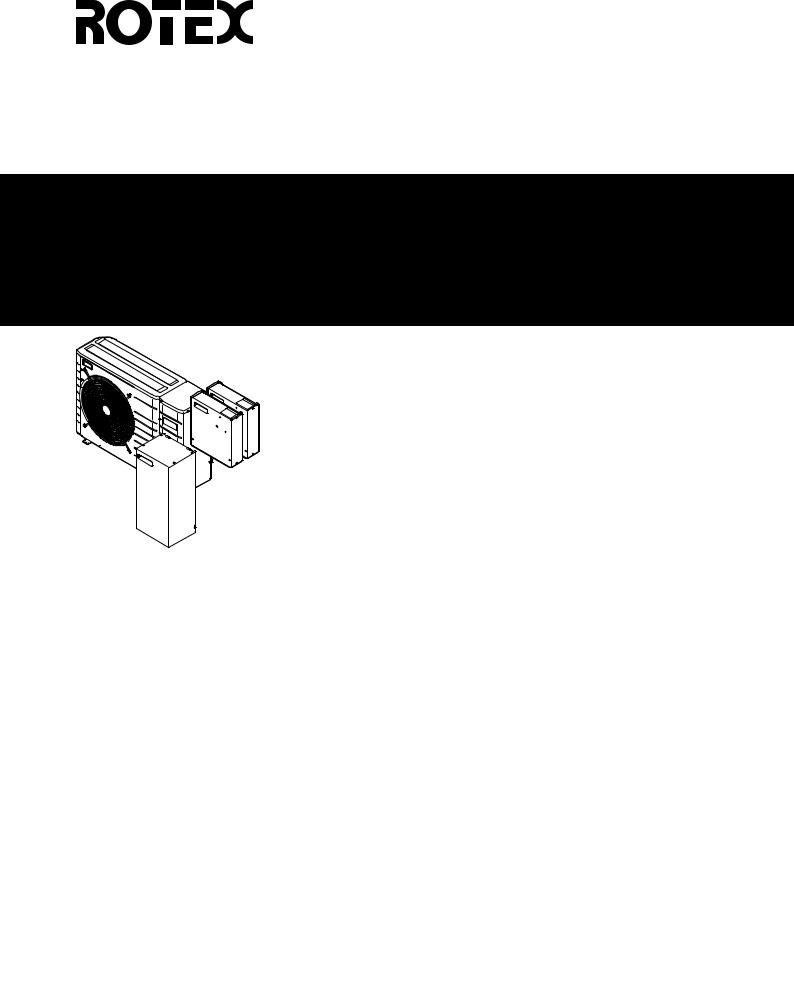
Installer reference guide
ROTEX HPSU low temperature monobloc
RBLQ05+07CAV3
RDLQ05+07CAV3
RKCB07CAV3
RK2CB07CAV3
RKMBUHCA3V3 |
Installer reference guide |
English |
RKMBUHCA9W1 |
ROTEX HPSU low temperature monobloc |
|
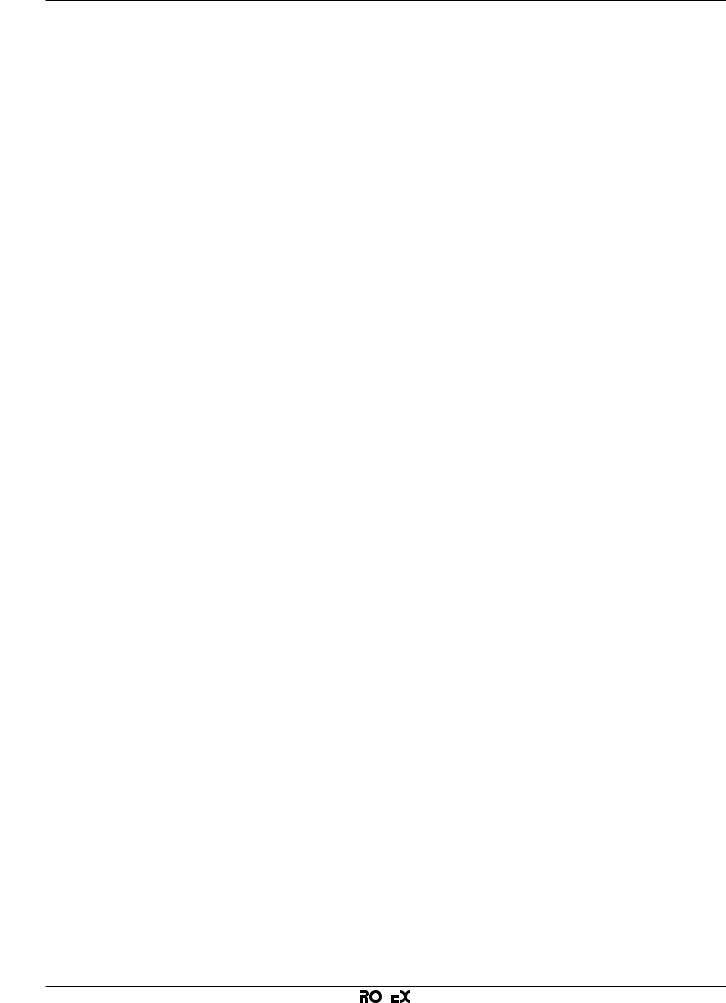
Table of Contents
Table of Contents
5.6.2 |
Power limitation activated by digital inputs .................. |
23 |
5.6.3 |
Power limitation process .............................................. |
23 |
5.7 Setting up an external temperature sensor ................................ |
24 |
|
6 Preparation |
24 |
|
1 General safety precautions |
4 |
||
1.1 |
About the documentation .......................................................... |
4 |
|
|
1.1.1 Meaning of warnings and symbols.............................. |
4 |
|
1.2 |
For the installer.......................................................................... |
4 |
|
|
1.2.1 |
General ....................................................................... |
4 |
|
1.2.2 |
Installation site ............................................................ |
4 |
|
1.2.3 |
Refrigerant .................................................................. |
5 |
|
1.2.4 |
Brine............................................................................ |
5 |
|
1.2.5 |
Water .......................................................................... |
5 |
|
1.2.6 |
Electrical ..................................................................... |
6 |
2 |
About the documentation |
6 |
||
|
2.1 |
About this document.................................................................. |
6 |
|
|
2.2 |
Installer reference guide at a glance ......................................... |
7 |
|
3 |
About the box |
7 |
||
|
3.1 |
Overview: About the box ........................................................... |
7 |
|
|
3.2 |
Outdoor unit............................................................................... |
7 |
|
|
|
3.2.1 |
To unpack the outdoor unit ......................................... |
7 |
|
|
3.2.2 |
To remove the accessories from the outdoor unit....... |
8 |
|
3.3 |
Control box ................................................................................ |
8 |
|
|
|
3.3.1 |
To unpack the control box........................................... |
8 |
|
|
3.3.2 |
To remove the accessories from the control box ........ |
8 |
|
3.4 |
Option box ................................................................................. |
8 |
|
|
|
3.4.1 |
To unpack the option box............................................ |
8 |
|
|
3.4.2 |
To remove the accessories from the option box ......... |
9 |
|
3.5 |
Backup heater ........................................................................... |
9 |
|
|
|
3.5.1 |
To unpack the backup heater ..................................... |
9 |
|
|
3.5.2 |
To remove the accessories from the backup heater... |
9 |
4 About the units and options |
9 |
|||
|
4.1 |
Overview: About the units and options...................................... |
9 |
|
|
4.2 |
Identification .............................................................................. |
9 |
|
|
|
4.2.1 |
Identification label: Outdoor unit ................................. |
10 |
|
|
4.2.2 |
Identification label: Control box................................... |
10 |
|
|
4.2.3 |
Identification label: Option box.................................... |
10 |
|
|
4.2.4 |
Identification label: Backup heater .............................. |
10 |
|
4.3 |
Combining units and options ..................................................... |
10 |
|
|
|
4.3.1 |
Possible combinations of outdoor unit and options..... |
10 |
|
|
4.3.2 |
Possible options for the outdoor unit........................... |
11 |
|
|
4.3.3 |
Possible options for the control box ............................ |
12 |
|
|
4.3.4 |
Possible options for the option box ............................. |
12 |
4.3.5Possible combinations of outdoor unit and domestic
|
|
|
hot water tank ............................................................. |
12 |
|
5 Application guidelines |
13 |
||
5.1 |
Overview: Application guidelines............................................... |
13 |
||
5.2 |
Setting up the space heating/cooling system ............................ |
13 |
||
|
|
5.2.1 |
Single room................................................................. |
13 |
|
|
5.2.2 |
Multiple rooms – One LWT zone ................................ |
15 |
|
|
5.2.3 |
Multiple rooms – Two LWT zones............................... |
17 |
5.3 |
Setting up an auxiliary heat source for space heating............... |
18 |
||
5.4 |
Setting up the domestic hot water tank ..................................... |
19 |
||
|
|
5.4.1 |
System layout – Standalone DHW tank...................... |
19 |
|
|
5.4.2 |
Selecting the volume and desired temperature for |
|
|
|
|
the DHW tank.............................................................. |
19 |
|
|
5.4.3 |
Setup and configuration – DHW tank.......................... |
20 |
|
|
5.4.4 |
DHW pump for instant hot water................................. |
20 |
|
|
5.4.5 |
DHW pump for disinfection ......................................... |
20 |
5.5 |
Setting up the energy metering ................................................. |
21 |
||
|
|
5.5.1 |
Produced heat............................................................. |
21 |
|
|
5.5.2 |
Consumed energy....................................................... |
21 |
|
|
5.5.3 |
Normal kWh rate power supply................................... |
21 |
|
|
5.5.4 |
Preferential kWh rate power supply |
22 |
|
|
|||
|
5.6 |
Setting up the power consumption control ................................ |
22 |
|
|
|
5.6.1 |
Permanent power limitation ........................................ |
22 |
|
|
|
|
|
6.1 |
Overview: Preparation................................................................ |
24 |
|
6.2 |
Preparing installation site ........................................................... |
24 |
|
|
6.2.1 |
Installation site requirements of the outdoor unit ......... |
24 |
6.2.2Additional installation site requirements of the
|
|
outdoor unit in cold climates ........................................ |
25 |
|
6.2.3 |
Installation site requirements of the control box........... |
25 |
|
6.2.4 |
Installation site requirements of the option box............ |
26 |
|
6.2.5 |
Installation site requirements of the backup heater ..... |
26 |
6.3 |
Preparing water piping ............................................................... |
26 |
|
|
6.3.1 |
Water circuit requirements ........................................... |
26 |
6.3.2Formula to calculate the expansion vessel pre-
|
|
pressure ....................................................................... |
28 |
|
6.3.3 |
To check the water volume and flow rate .................... |
28 |
|
6.3.4 |
Changing the pre-pressure of the expansion vessel.... |
29 |
|
6.3.5 |
To check the water volume: Examples ........................ |
29 |
6.4 |
Preparing electrical wiring .......................................................... |
29 |
|
|
6.4.1 |
About preparing electrical wiring.................................. |
29 |
|
6.4.2 |
About preferential kWh rate power supply ................... |
29 |
6.4.3Overview of electrical connections except external
actuators ...................................................................... |
29 |
6.4.4Overview of electrical connections for external and
|
|
internal actuators ......................................................... |
30 |
7 Installation |
31 |
||
7.1 |
Overview: Installation ................................................................. |
31 |
|
7.2 |
Opening the units ....................................................................... |
32 |
|
|
7.2.1 |
About opening the units ............................................... |
32 |
|
7.2.2 |
To open the outdoor unit.............................................. |
32 |
|
7.2.3 |
To open the switch box cover of the outdoor unit ........ |
32 |
|
7.2.4 |
To open the control box ............................................... |
32 |
|
7.2.5 |
To open the option box ................................................ |
32 |
|
7.2.6 |
To open the backup heater .......................................... |
33 |
|
7.2.7 |
To open the switch box cover of the backup heater .... |
33 |
7.3 |
Mounting the outdoor unit........................................................... |
33 |
|
|
7.3.1 |
About mounting the outdoor unit.................................. |
33 |
|
7.3.2 |
Precautions when mounting the outdoor unit............... |
33 |
|
7.3.3 |
To provide the installation structure ............................. |
33 |
|
7.3.4 |
To install the outdoor unit............................................. |
34 |
|
7.3.5 |
To provide drainage ..................................................... |
35 |
|
7.3.6 |
To prevent the outdoor unit from falling over ............... |
35 |
7.4 |
Mounting the control box ............................................................ |
36 |
|
|
7.4.1 |
About mounting the control box ................................... |
36 |
|
7.4.2 |
Precautions when mounting the control box ................ |
36 |
|
7.4.3 |
To install the control box .............................................. |
36 |
7.5 |
Mounting the option box ............................................................. |
36 |
|
|
7.5.1 |
About mounting the option box .................................... |
36 |
|
7.5.2 |
Precautions when mounting the option box ................. |
36 |
|
7.5.3 |
To install the option box ............................................... |
36 |
7.6 |
Mounting the backup heater....................................................... |
36 |
|
|
7.6.1 |
About mounting the backup heater .............................. |
36 |
|
7.6.2 |
Precautions when mounting the backup heater........... |
36 |
|
7.6.3 |
To install the backup heater......................................... |
36 |
7.7 |
Connecting the water piping....................................................... |
37 |
|
|
7.7.1 |
About connecting the water piping............................... |
37 |
|
7.7.2 |
Precautions when connecting the water piping............ |
37 |
|
7.7.3 |
To connect the water piping......................................... |
37 |
|
7.7.4 |
To connect the water piping to the backup heater ....... |
38 |
|
7.7.5 |
About the valve kit........................................................ |
38 |
|
7.7.6 |
To protect the water circuit against freezing ................ |
39 |
|
7.7.7 |
To fill the water circuit .................................................. |
40 |
|
7.7.8 |
To fill the domestic hot water tank ............................... |
41 |
|
7.7.9 |
To insulate the water piping ......................................... |
41 |
7.8 |
Connecting the electrical wiring.................................................. |
41 |
|
|
7.8.1 |
About connecting the electrical wiring.......................... |
41 |
|
7.8.2 |
Precautions when connecting the electrical wiring ...... |
41 |
Installer reference guide |
|
|
|
RBLQ05+07CAV3 + RDLQ05+07CAV3 + RKCB07CAV3 + |
|
|
|||
2 |
|
|
|
RK2CB07CAV3 + RKMBUHCA3V3 + RKMBUHCA9W1 |
|
|
|
ROTEX HPSU low temperature monobloc |
|
|
|
|
|
4P415097-1A – 2016.02 |
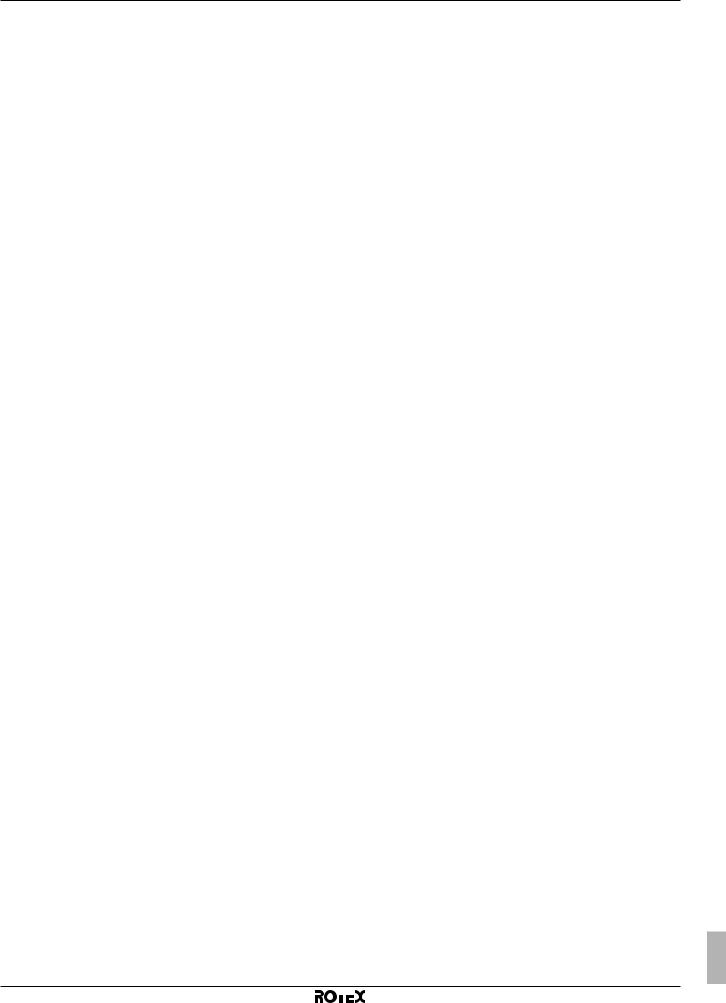
Table of Contents
7.8.3 |
Guidelines when connecting the electrical wiring ....... |
41 |
7.8.4 |
To connect the electrical wiring on the outdoor unit.... |
41 |
7.8.5 |
To connect the main power supply ............................. |
42 |
7.8.6 |
To connect the user interface ..................................... |
43 |
7.8.7 |
To connect the shut-off valve...................................... |
44 |
7.8.8 |
To connect the domestic hot water pump ................... |
45 |
7.8.9 |
To connect the electrical wiring on the control box ..... |
45 |
7.8.10 |
To connect the control box power supply ................... |
45 |
7.8.11To connect the interconnection cable between
|
control box and outdoor unit ....................................... |
45 |
7.8.12 |
To connect the electrical wiring on the option box ...... |
46 |
7.8.13 |
To connect the option box power supply .................... |
46 |
7.8.14To connect the interconnection cable between option
|
|
|
box and control box..................................................... |
46 |
|
|
7.8.15 |
To connect the electrical meters ................................. |
46 |
|
|
7.8.16 |
To connect the power consumption digital inputs ....... |
47 |
|
|
7.8.17 |
To connect the alarm output ....................................... |
47 |
|
|
7.8.18 |
To connect the space cooling/heating ON/OFF |
|
|
|
|
output .......................................................................... |
47 |
|
|
7.8.19 |
To connect the changeover to external heat source... |
47 |
|
|
7.8.20 |
To connect the electrical wiring on the backup heater |
48 |
|
|
7.8.21 |
To connect the backup heater power supply .............. |
48 |
|
|
7.8.22 |
To connect the backup heater kit to the control box ... |
49 |
|
|
7.8.23 |
To connect the valve kit .............................................. |
49 |
|
7.9 |
Finishing the outdoor unit installation ........................................ |
50 |
|
|
|
7.9.1 |
To close the outdoor unit ............................................ |
50 |
|
7.10 |
Finishing the control box installation ......................................... |
50 |
|
|
|
7.10.1 |
To close the control box.............................................. |
50 |
|
7.11 |
Finishing the option box installation .......................................... |
50 |
|
|
|
7.11.1 |
To close the option box............................................... |
50 |
|
7.12 |
Finishing the backup heater installation .................................... |
50 |
|
|
|
7.12.1 |
To close the backup heater......................................... |
50 |
8 |
Configuration |
51 |
||
|
8.1 |
Overview: Configuration ............................................................ |
51 |
|
|
|
8.1.1 |
To connect the PC cable to the switch box................. |
51 |
|
|
8.1.2 |
To access the most used commands ......................... |
51 |
|
|
8.1.3 |
To copy the system settings from the first to the |
|
|
|
|
second user interface.................................................. |
52 |
|
|
8.1.4 |
To copy the language set from the first to the second |
|
|
|
|
user interface .............................................................. |
53 |
|
|
8.1.5 |
Quick wizard: Set the system layout after first power |
|
|
|
|
ON............................................................................... |
53 |
|
8.2 |
Basic configuration .................................................................... |
53 |
|
|
|
8.2.1 |
Quick wizard: Language / time and date..................... |
53 |
|
|
8.2.2 |
Quick wizard: Standard............................................... |
53 |
|
|
8.2.3 |
Quick wizard: Options ................................................. |
55 |
|
|
8.2.4 |
Quick wizard: Capacities (energy metering) ............... |
57 |
|
|
8.2.5 |
Space heating/cooling control..................................... |
57 |
|
|
8.2.6 |
Domestic hot water control ......................................... |
61 |
|
|
8.2.7 |
Contact/helpdesk number ........................................... |
62 |
|
8.3 |
Advanced configuration/optimization......................................... |
62 |
|
|
|
8.3.1 |
Space heating/cooling operation: advanced ............... |
62 |
|
|
8.3.2 |
Domestic hot water control: advanced........................ |
66 |
|
|
8.3.3 |
Heat source settings ................................................... |
70 |
|
|
8.3.4 |
System settings........................................................... |
71 |
|
8.4 |
Menu structure: Overview user settings .................................... |
76 |
|
|
8.5 |
Menu structure: Overview installer settings............................... |
77 |
|
9 |
Commissioning |
78 |
||
|
9.1 |
Overview: Commissioning......................................................... |
78 |
|
|
9.2 |
Precautions when commissioning ............................................. |
78 |
|
|
9.3 |
Checklist before commissioning................................................ |
78 |
|
|
9.4 |
Checklist during commissioning ................................................ |
78 |
|
|
|
9.4.1 |
To check the minimum flow rate ................................. |
78 |
|
|
9.4.2 |
Air purge function........................................................ |
79 |
|
|
9.4.3 |
To perform a test run .................................................. |
80 |
|
|
9.4.4 |
To perform an actuator test run .................................. |
80 |
|
|
9.4.5 |
Underfloor heating screed dryout................................ |
80 |
10.1 About locking and unlocking....................................................... |
82 |
Possible function locks ............................................................... |
82 |
To check if locking is active........................................................ |
82 |
To activate or deactivate a function lock .................................... |
82 |
To activate or deactivate button lock.......................................... |
82 |
11 Maintenance and service |
82 |
|
11.1 |
Overview: Maintenance and service .......................................... |
82 |
11.2 |
Maintenance safety precautions................................................. |
82 |
|
11.2.1 Opening the outdoor unit ............................................. |
83 |
|
11.2.2 Opening the control box............................................... |
83 |
|
11.2.3 Opening the option box................................................ |
83 |
|
11.2.4 Opening the backup heater.......................................... |
83 |
11.3 |
Checklist for yearly maintenance of the outdoor unit ................. |
83 |
12 Troubleshooting |
83 |
||
12.1 |
Overview: Troubleshooting......................................................... |
83 |
|
12.2 |
Precautions when troubleshooting ............................................. |
84 |
|
12.3 Solving problems based on symptoms....................................... |
84 |
||
|
12.3.1 |
Symptom: The unit is NOT heating or cooling as |
|
|
|
expected ...................................................................... |
84 |
|
12.3.2 |
Symptom: The compressor does NOT start (space |
|
|
|
heating or domestic water heating).............................. |
84 |
|
12.3.3 |
Symptom: The pump is making noise (cavitation) ....... |
84 |
|
12.3.4 |
Symptom: The pressure relief valve opens.................. |
85 |
|
12.3.5 |
Symptom: The water pressure relief valve leaks ......... |
85 |
|
12.3.6 |
Symptom: The space is NOT sufficiently heated at |
|
|
|
low outdoor temperatures ............................................ |
85 |
|
12.3.7 |
Symptom: The pressure at the tapping point is |
|
|
|
temporarily unusual high.............................................. |
86 |
|
12.3.8 |
Symptom: Decoration panels are pushed away due |
|
|
|
to a swollen tank .......................................................... |
86 |
|
12.3.9 |
Symptom: Tank disinfection function is NOT |
|
|
|
completed correctly (AH-error)..................................... |
86 |
|
12.3.10 |
Symptom: The energy metering (produced heat) is |
|
|
|
NOT working correctly ................................................. |
86 |
12.4 Solving problems based on error codes..................................... |
86 |
||
|
12.4.1 |
Error codes: Overview ................................................. |
86 |
13 Disposal |
89 |
|
13.1 |
Overview: Disposal..................................................................... |
89 |
13.2 |
To pump down............................................................................ |
89 |
13.3 |
To start and stop forced cooling ................................................. |
89 |
14 Technical data |
90 |
||
14.1 |
Overview: Technical data ........................................................... |
90 |
|
14.2 |
Dimensions and service space................................................... |
90 |
|
|
14.2.1 Dimensions and service space: Outdoor unit .............. |
90 |
|
|
14.2.2 Dimensions and service space: Options...................... |
91 |
|
14.3 |
Center of gravity ......................................................................... |
93 |
|
|
14.3.1 Center of gravity: Outdoor unit..................................... |
93 |
|
|
14.3.2 Center of gravity: Options ............................................ |
94 |
|
14.4 |
Components ............................................................................... |
95 |
|
|
14.4.1 |
Components: Outdoor unit........................................... |
95 |
|
14.4.2 Components: Switch box (outdoor unit)....................... |
96 |
|
|
14.4.3 |
Components: Options .................................................. |
97 |
|
14.4.4 Components: Switch box (options) .............................. |
99 |
|
14.5 |
Piping diagram ........................................................................... |
100 |
|
|
14.5.1 Piping diagram: Outdoor unit ....................................... |
100 |
|
14.6 |
Wiring diagram ........................................................................... |
101 |
|
|
14.6.1 Wiring diagram: Outdoor unit ....................................... |
101 |
|
14.7 |
Operation range ......................................................................... |
109 |
|
|
14.7.1 |
Valve kit necessity ....................................................... |
109 |
14.8 |
ESP curve .................................................................................. |
110 |
|
|
14.8.1 ESP curve: Outdoor unit .............................................. |
110 |
|
15 Glossary |
|
111 |
|
16 Field settings table |
112 |
||
10 Hand-over to the user |
82 |
|
|
|
|
RBLQ05+07CAV3 + RDLQ05+07CAV3 + RKCB07CAV3 + RK2CB07CAV3 + RKMBUHCA3V3 + RKMBUHCA9W1 ROTEX HPSU low temperature monobloc
4P415097-1A – 2016.02
Installer reference guide
3
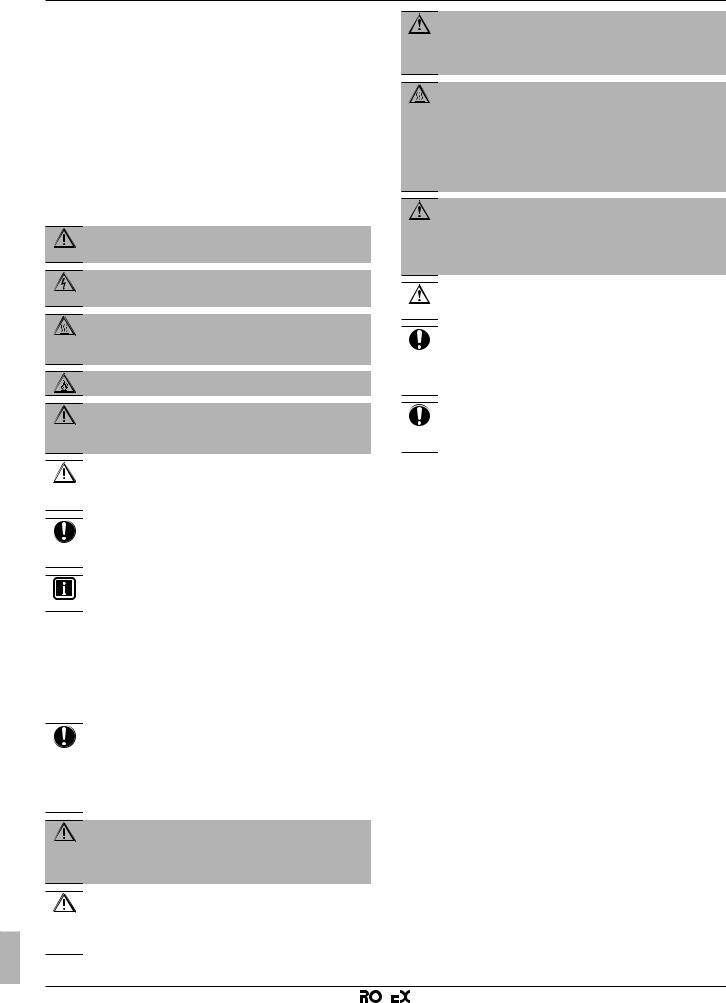
1 General safety precautions
1 General safety precautions
1.1About the documentation
▪The original documentation is written in English. All other languages are translations.
▪The precautions described in this document cover very important topics, follow them carefully.
▪The installation of the system, and all activities described in the installation manual and the installer reference guide must be performed by an authorized installer.
1.1.1Meaning of warnings and symbols
DANGER
Indicates a situation that results in death or serious injury.
DANGER: RISK OF ELECTROCUTION
Indicates a situation that could result in electrocution.
DANGER: RISK OF BURNING
Indicates a situation that could result in burning because of extreme hot or cold temperatures.
WARNING: FLAMMABLE MATERIAL
WARNING
Indicates a situation that could result in death or serious injury.
CAUTION
Indicates a situation that could result in minor or moderate injury.
NOTICE
Indicates a situation that could result in equipment or property damage.
INFORMATION
Indicates useful tips or additional information.
WARNING
Tear apart and throw away plastic packaging bags so that nobody, especially children, can play with them. Possible risk: suffocation.
DANGER: RISK OF BURNING
▪Do NOT touch the refrigerant piping, water piping or internal parts during and immediately after operation. It could be too hot or too cold. Give it time to return to normal temperature. If you must touch it, wear protective gloves.
▪Do NOT touch any accidental leaking refrigerant.
WARNING
Provide adequate measures to prevent that the unit can be used as a shelter by small animals. Small animals that make contact with electrical parts can cause malfunctions, smoke or fire.
CAUTION
Do NOT touch the air inlet or aluminum fins of the unit.
NOTICE
▪Do NOT place any objects or equipment on top of the unit.
▪Do NOT sit, climb or stand on the unit.
NOTICE
Works executed on the outdoor unit are best done under dry weather conditions to avoid water ingress.
In accordance with the applicable legislation, it might be necessary to provide a logbook with the product containing at least: information on maintenance, repair work, results of tests, stand-by periods,…
Also, at least, following information must be provided at an accessible place at the product:
▪Instructions for shutting down the system in case of an emergency
▪Name and address of fire department, police and hospital
▪Name, address and day and night telephone numbers for obtaining service
In Europe, EN378 provides the necessary guidance for this logbook.
1.2For the installer
1.2.1General
If you are not sure how to install or operate the unit, contact your dealer.
NOTICE
Improper installation or attachment of equipment or accessories could result in electric shock, short-circuit, leaks, fire or other damage to the equipment. Only use accessories, optional equipment and spare parts made or approved by ROTEX.
WARNING
Make sure installation, testing and applied materials comply with applicable legislation (on top of the instructions described in the ROTEX documentation).
CAUTION
Wear adequate personal protective equipment (protective gloves, safety glasses,…) when installing, maintaining or servicing the system.
1.2.2Installation site
▪Provide sufficient space around the unit for servicing and air circulation.
▪Make sure the installation site withstands the unit's weight and vibration.
▪Make sure the area is well ventilated. Do NOT block any ventilation openings.
▪Make sure the unit is level.
Do NOT install the unit in the following places:
▪In potentially explosive atmospheres.
▪In places where there is machinery that emits electromagnetic waves. Electromagnetic waves may disturb the control system, and cause malfunction of the equipment.
▪In places where there is a risk of fire due to the leakage of flammable gases (example: thinner or gasoline), carbon fibre, ignitable dust.
▪In places where corrosive gas (example: sulphurous acid gas) is produced. Corrosion of copper pipes or soldered parts may cause the refrigerant to leak.
Installer reference guide |
|
|
|
RBLQ05+07CAV3 + RDLQ05+07CAV3 + RKCB07CAV3 + |
|
|
|||
4 |
|
|
|
RK2CB07CAV3 + RKMBUHCA3V3 + RKMBUHCA9W1 |
|
|
|
ROTEX HPSU low temperature monobloc |
|
|
|
|
|
4P415097-1A – 2016.02 |

1 General safety precautions
1.2.3Refrigerant
If applicable. See the installation manual or installer reference guide of your application for more information.
NOTICE
Make sure refrigerant piping installation complies with applicable legislation. In Europe, EN378 is the applicable standard.
NOTICE
Make sure the field piping and connections are not subjected to stress.
WARNING
During tests, NEVER pressurize the product with a pressure higher than the maximum allowable pressure (as indicated on the nameplate of the unit).
WARNING
Take sufficient precautions in case of refrigerant leakage. If refrigerant gas leaks, ventilate the area immediately. Possible risks:
▪Excessive refrigerant concentrations in a closed room can lead to oxygen deficiency.
▪Toxic gas may be produced if refrigerant gas comes into contact with fire.
WARNING
Always recover the refrigerant. Do NOT release them directly into the environment. Use a vacuum pump to evacuate the installation.
NOTICE
After all the piping has been connected, make sure there is no gas leak. Use nitrogen to perform a gas leak detection.
NOTICE
▪To avoid compressor breakdown, do NOT charge more than the specified amount of refrigerant.
▪When the refrigerant system is to be opened, refrigerant must be treated according to the applicable legislation.
WARNING
Make sure there is no oxygen in the system. Refrigerant may only be charged after performing the leak test and the vacuum drying.
▪In case re-charge is required, refer to the nameplate of the unit. It states the type of refrigerant and necessary amount.
▪The unit is factory charged with refrigerant and depending on pipe sizes and pipe lengths some systems require additional charging of refrigerant.
▪Only use tools exclusively for the refrigerant type used in the system, this to ensure pressure resistance and prevent foreign materials from entering into the system.
▪Charge the liquid refrigerant as follows:
If |
Then |
A siphon tube is present |
Charge with the cylinder upright. |
(i.e., the cylinder is marked with "Liquid filling siphon attached")
If |
Then |
||
A siphon tube is NOT present |
Charge with the cylinder upside |
||
|
down. |
||
|
|
|
|
|
|
|
|
▪Open refrigerant cylinders slowly.
▪Charge the refrigerant in liquid form. Adding it in gas form may prevent normal operation.
CAUTION
When the refrigerant charging procedure is done or when pausing, close the valve of the refrigerant tank immediately. If the valve is not closed immediately, remaining pressure might charge additional refrigerant.
Possible consequence: Incorrect refrigerant amount.
1.2.4Brine
If applicable. See the installation manual or installer reference guide of your application for more information.
WARNING
The selection of the brine MUST be in accordance with the applicable legislation.
WARNING
Take sufficient precautions in case of brine leakage. If brine leaks, ventilate the area immediately and contact your local dealer.
WARNING
The ambient temperature inside the unit can get much higher than that of the room, e.g. 70°C. In case of a brine leak, hot parts inside the unit can create a hazardous situation.
WARNING
The use and installation of the application MUST comply with the safety and environmental precautions specified in the applicable legislation.
1.2.5Water
If applicable. See the installation manual or installer reference guide of your application for more information.
NOTICE
Make sure water quality complies with EU directive
98/83 EC.
RBLQ05+07CAV3 + RDLQ05+07CAV3 + RKCB07CAV3 + RK2CB07CAV3 + RKMBUHCA3V3 + RKMBUHCA9W1 ROTEX HPSU low temperature monobloc
4P415097-1A – 2016.02
Installer reference guide
5
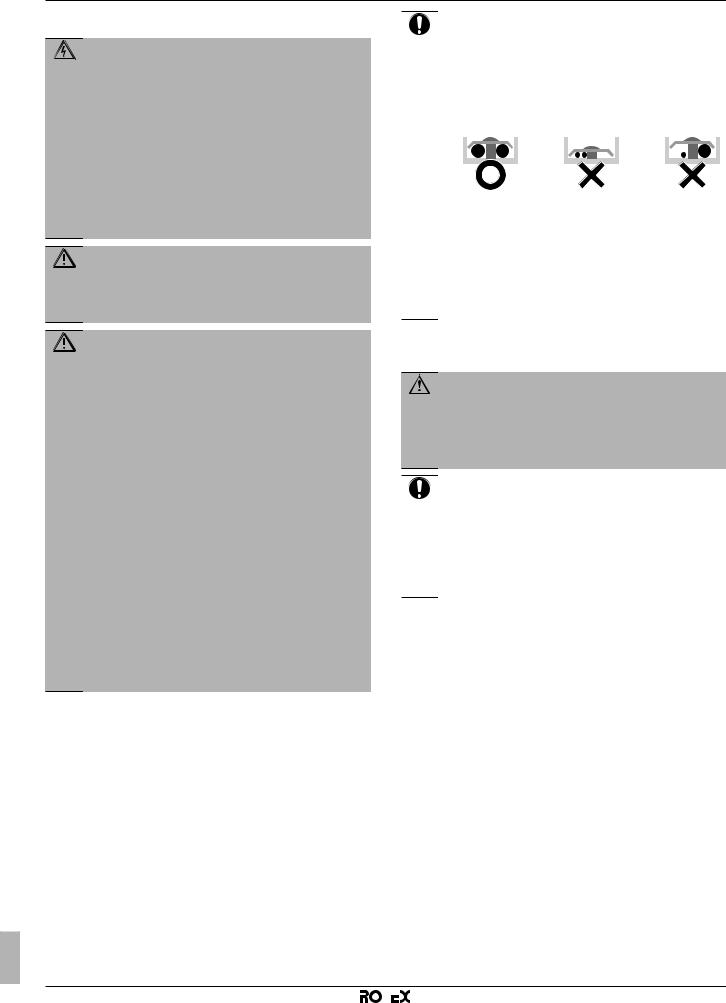
2 About the documentation
1.2.6Electrical
DANGER: RISK OF ELECTROCUTION
▪Turn OFF all power supply before removing the switch box cover, connecting electrical wiring or touching electrical parts.
▪Disconnect the power supply for more than 1 minute, and measure the voltage at the terminals of main circuit capacitors or electrical components before servicing. The voltage MUST be less than 50 V DC before you can touch electrical components. For the location of the terminals, see the wiring diagram.
▪Do NOT touch electrical components with wet hands.
▪Do NOT leave the unit unattended when the service cover is removed.
WARNING
If NOT factory installed, a main switch or other means for disconnection, having a contact separation in all poles providing full disconnection under overvoltage category III condition, shall be installed in the fixed wiring.
WARNING
▪ONLY use copper wires.
▪Make sure the field wiring complies with the applicable legislation.
▪All field wiring must be performed in accordance with the wiring diagram supplied with the product.
▪NEVER squeeze bundled cables and make sure they do not come in contact with the piping and sharp edges. Make sure no external pressure is applied to the terminal connections.
▪Make sure to install earth wiring. Do NOT earth the unit to a utility pipe, surge absorber, or telephone earth. Incomplete earth may cause electrical shock.
▪Make sure to use a dedicated power circuit. NEVER use a power supply shared by another appliance.
▪Make sure to install the required fuses or circuit breakers.
▪Make sure to install an earth leakage protector. Failure to do so may cause electric shock or fire.
▪When installing the earth leakage protector, make sure it is compatible with the inverter (resistant to high frequency electric noise) to avoid unnecessary opening of the earth leakage protector.
NOTICE
Precautions when laying power wiring:
▪Do not connect wiring of different thicknesses to the power terminal block (slack in the power wiring may cause abnormal heat).
▪When connecting wiring which is the same thickness, do as shown in the figure below.
▪For wiring, use the designated power wire and connect firmly, then secure to prevent outside pressure being exerted on the terminal board.
▪Use an appropriate screwdriver for tightening the terminal screws. A screwdriver with a small head will damage the head and make proper tightening impossible.
▪Over-tightening the terminal screws may break them.
Install power cables at least 1 metre away from televisions or radios to prevent interference. Depending on the radio waves, a distance of 1 metre may not be sufficient.
WARNING
▪After finishing the electrical work, confirm that each electrical component and terminal inside the electrical components box is connected securely.
▪Make sure all covers are closed before starting up the unit.
NOTICE
Only applicable if the power supply is three phase, and the compressor has an ON/OFF starting method.
If there exists the possibility of reversed phase after a momentary black out and the power goes on and off while the product is operating, attach a reversed phase protection circuit locally. Running the product in reversed phase can break the compressor and other parts.
2 About the documentation
2.1About this document
Target audience
Authorised installers
Documentation set
This document is part of a documentation set. The complete set consists of:
▪General safety precautions:
▪Safety instructions that you must read before installing
▪Format: Paper (in the box of the outdoor unit)
▪Outdoor unit installation manual:
▪Installation instructions
▪Format: Paper (in the box of the outdoor unit)
▪Control box installation manual:
▪Installation instructions
▪Format: Paper (in the box of the control box)
Installer reference guide |
|
|
|
RBLQ05+07CAV3 + RDLQ05+07CAV3 + RKCB07CAV3 + |
|
|
|||
6 |
|
|
|
RK2CB07CAV3 + RKMBUHCA3V3 + RKMBUHCA9W1 |
|
|
|
ROTEX HPSU low temperature monobloc |
|
|
|
|
|
4P415097-1A – 2016.02 |
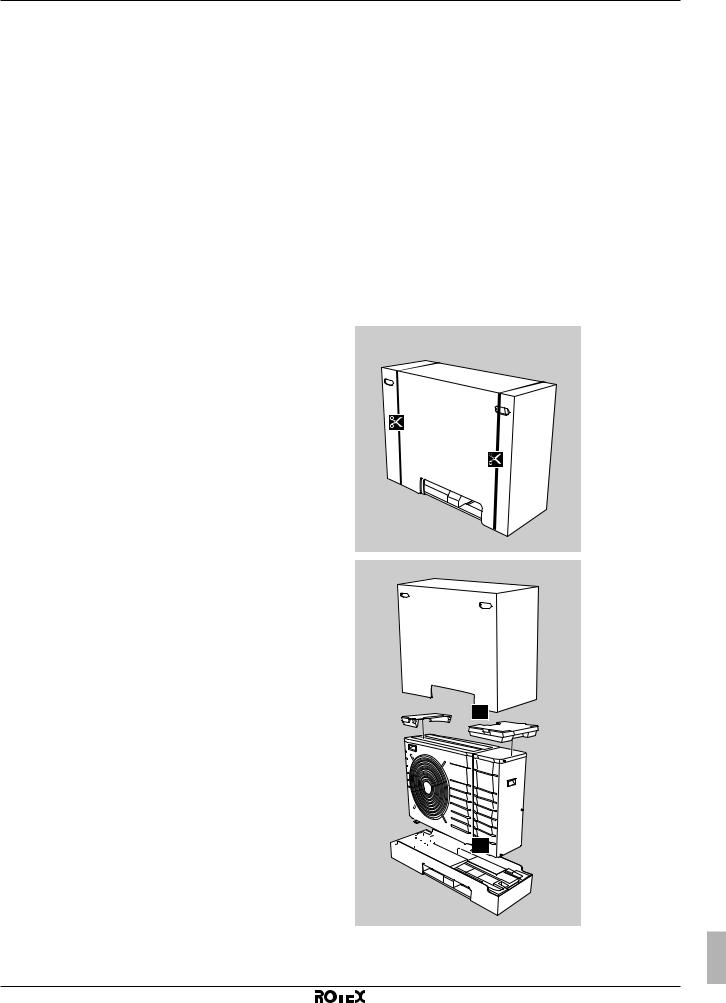
3 About the box
▪Option box installation manual:
▪Installation instructions
▪Format: Paper (in the box of the option box)
▪Backup heater installation manual:
▪Installation instructions
▪Format: Paper (in the box of the backup heater)
▪Installer reference guide:
▪Preparation of the installation, technical specifications, good practices, reference data,…
▪Format: Digital files on the ROTEX homepage
▪Addendum book for optional equipment:
▪Additional info about how to install optional equipment
▪Format: Paper (in the box of the outdoor unit) + Digital files on the ROTEX homepage
Latest revisions of the supplied documentation may be available on the regional ROTEX website or via your dealer.
The original documentation is written in English. All other languages are translations.
3 About the box
3.1Overview: About the box
This chapter describes what you have to do after the boxes with the outdoor unit, control box, and/or backup heater are delivered on-site.
It contains information about:
▪Unpacking and handling the units
▪Removing the accessories from the units
Keep the following in mind:
▪At delivery, the unit must be checked for damage. Any damage must be reported immediately to the carrier's claims agent.
▪Bring the packed unit as close as possible to its final installation position to prevent damage during transport.
3.2Outdoor unit
3.2.1To unpack the outdoor unit
2.2Installer reference guide at a glance
Chapter |
Description |
|
|
General safety |
Safety instructions that you must read |
|
|
precautions |
before installing |
|
|
About the documentation |
What documentation exists for the |
|
|
|
installer |
|
|
About the box |
How to unpack the units and remove |
|
|
|
their accessories |
|
|
About the units and |
▪ How to identify the units |
|
|
options |
▪ Possible combinations of units and |
|
|
|
|
|
|
|
options |
|
|
|
|
|
|
Application guidelines |
Various installation setups of the system |
|
|
Preparation |
What to do and know before going |
|
|
|
on site |
|
|
Installation |
What to do and know to install the |
|
|
|
system |
|
|
Configuration |
What to do and know to configure the |
|
|
|
system after it is installed |
|
|
Commissioning |
What to do and know to commission the |
|
|
|
system after it is configured |
|
|
Hand over to the user |
What to give and explain to the user |
|
|
|
|
|
|
Maintenance and service |
How to maintain and service the units |
|
|
Troubleshooting |
What to do in case of problems |
|
|
Disposal |
How to dispose of the system |
|
|
|
|
|
|
Technical data |
Specifications of the system |
|
|
Glossary |
Definition of terms |
|
|
|
|
|
|
Field settings table |
Table to be filled in by the installer, and |
|
|
|
kept for future reference |
|
|
|
Note: There is also an installer settings |
|
|
|
table in the user reference guide. This |
|
|
|
table has to be filled in by the installer |
|
|
|
and handed over to the user. |
|
|
|
|
|
|

 1
1



 2
2 

RBLQ05+07CAV3 + RDLQ05+07CAV3 + RKCB07CAV3 + RK2CB07CAV3 + RKMBUHCA3V3 + RKMBUHCA9W1 ROTEX HPSU low temperature monobloc
4P415097-1A – 2016.02
Installer reference guide
7
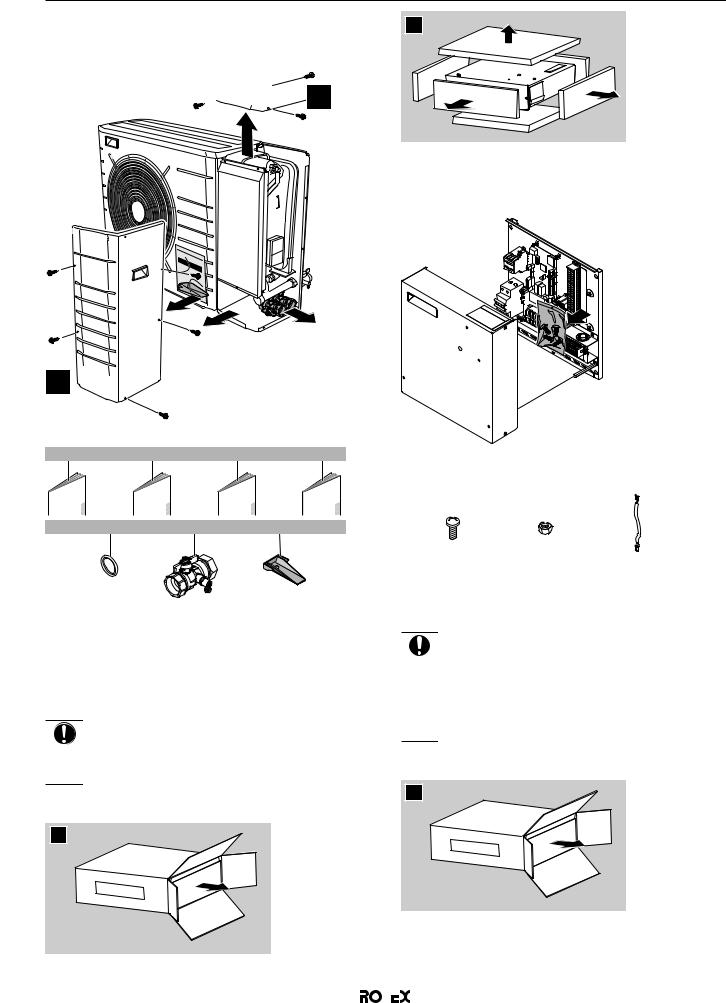
3 About the box
3.2.2To remove the accessories from the outdoor unit
1 Open the outdoor unit.

 3×
3× 
5× 

2 Remove the accessories.
a |
b |
c |
d |
1× |
1× |
1× |
1× |
e |
f |
|
g |
2× |
2× |
|
1× |
aGeneral safety precautions
bAddendum book for optional equipment
cOutdoor unit installation manual
dOperation manual
eSealing ring for shut-off valve
fShut-off valve
gUnit mounting plate
3.3Control box
NOTICE
Control box RKCB07CAV3 is an option and can only be
used in combination with outdoor units RDLQ05+07CAV3
and RBLQ05+07CAV3.
3.3.1To unpack the control box
1
2
3.3.2To remove the accessories from the control box
1 Open the control box.
2 Remove the accessories.
a |
b |
c |
|||
|
2× |
|
2× |
|
2× |
|
|
|
|
|
|
|
|
|
|
|
|
aM4 bolts for user interface
bM4 nuts for user interface
cWires for domestic hot water booster heater relay
3.4Option box
NOTICE
▪Option box RK2CB07CAV3 is an option and can only be used in combination with outdoor units RDLQ05+07CAV3 and RBLQ05+07CAV3.
▪To be able to use the option box, it is required that optional control box RKCB07CAV3 is part of the system.
3.4.1To unpack the option box
1
|
|
|
|
|
|
|
|
|
|
|
|
|
|
|
|
Installer reference guide |
|
|
|
RBLQ05+07CAV3 + RDLQ05+07CAV3 + RKCB07CAV3 + |
|
|
|
|
|
||
|
|
|||||
8 |
|
|
|
RK2CB07CAV3 + RKMBUHCA3V3 + RKMBUHCA9W1 |
||
|
|
|
ROTEX HPSU low temperature monobloc |
|||
|
|
|
|
|
|
4P415097-1A – 2016.02 |
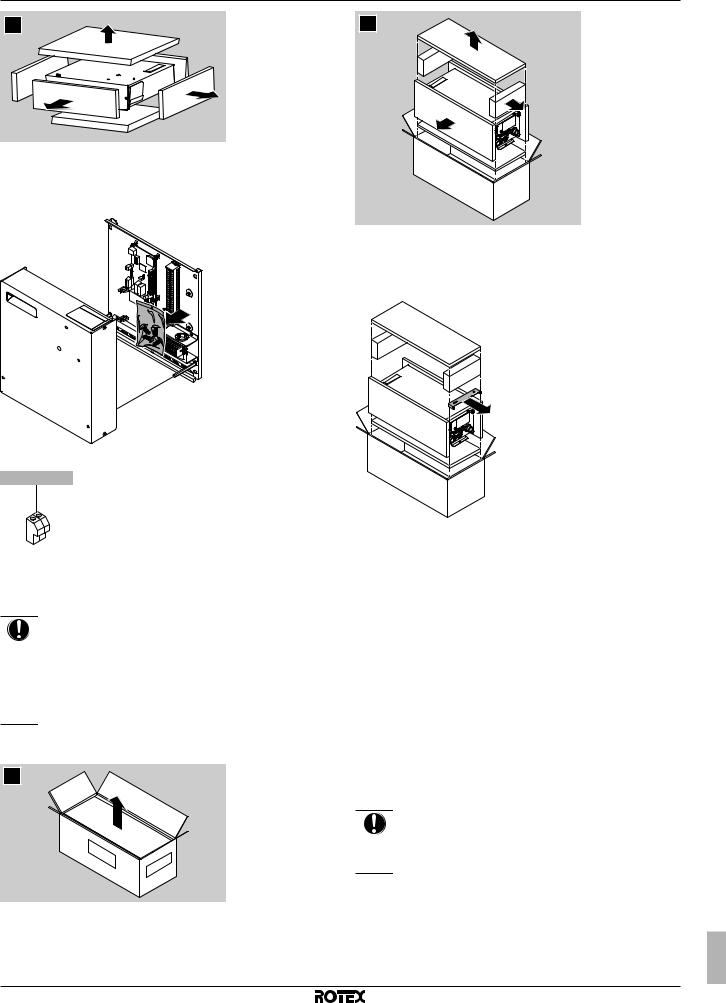
4 About the units and options
2
3.4.2To remove the accessories from the option box
1 Open the option box.
2 Remove the accessories.
a
2×
aConnectors for interconnection cable between the option box and control box RKCB07CAV3.
3.5Backup heater
NOTICE
▪The backup heater is an option and can only be used in combination with outdoor units RDLQ05+07CAV3 and
RBLQ05+07CAV3.
▪To be able to use the backup heater, it is required that optional control box RKCB07CAV3 is part of the system.
3.5.1To unpack the backup heater
1
2
3.5.2To remove the accessories from the backup heater
1 Remove the wall bracket from the box.
4 About the units and options
4.1Overview: About the units and options
This chapter contains information about:
▪Identifying the outdoor unit
▪Identifying the control box
▪Identifying the backup heater
▪Combining the outdoor unit with options
▪Combining the control box with options
▪Possible combinations of outdoor unit and control box
4.2Identification
NOTICE
When installing or servicing several units at the same time, make sure NOT to switch the service panels between different models.
RBLQ05+07CAV3 + RDLQ05+07CAV3 + RKCB07CAV3 + RK2CB07CAV3 + RKMBUHCA3V3 + RKMBUHCA9W1 ROTEX HPSU low temperature monobloc
4P415097-1A – 2016.02
Installer reference guide
9
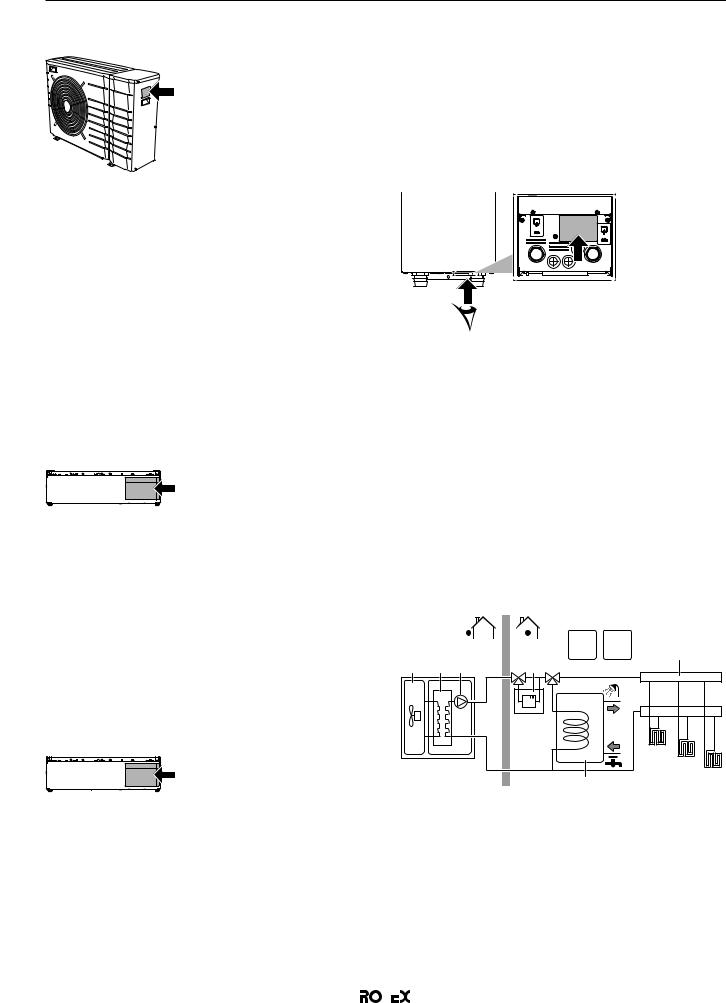
4 About the units and options
4.2.1Identification label: Outdoor unit
Location
Model identification
Example: R B/D L Q 05 CA V3
Code |
Explanation |
R |
Monobloc outdoor heat pump |
|
|
B |
B=Reversible (heating+cooling) |
D |
D=Heating only |
|
|
L |
Low water temperature – ambient zone: −10~ |
|
−25°C |
Q |
Refrigerant R410A |
05 |
Capacity class |
CA |
Model series |
|
|
V3 |
Power supply |
4.2.2Identification label: Control box
Location
Model identification
Example: RK CB 07 CA V3
Code |
Description |
RK |
ROTEX kit |
|
|
CB |
Control box |
07 |
Capacity class |
|
|
CA |
Model series |
|
|
V3 |
Power supply |
4.2.3Identification label: Option box
Location
Code |
Description |
RK |
ROTEX kit |
|
|
2 |
Optional |
CB |
Control box |
07 |
Capacity class |
|
|
CA |
Model series |
V3 |
Power supply |
|
|
4.2.4Identification label: Backup heater
Location
Model identification
Example: RK M BUH CA 3 V3
Code |
Explanation |
RK |
ROTEX kit |
|
|
M |
Designed for Monobloc |
BUH |
Backup heater |
|
|
CA |
Model series |
3 |
Capacity of heater kit (kW) |
V3 |
Power supply |
|
|
4.3Combining units and options
4.3.1Possible combinations of outdoor unit and options
f |
g |
i |
a |
b |
c |
d |
e |
d |
|
|
|
|
|
FHL1 |
|
|
|
|
|
FHL2 |
FHL3
h
Model identification
Example: RK 2 CB 07 CA V3
aOutdoor unit (RBLQ05+07CAV3 or RDLQ05+07CAV3)
bRefrigerant part of the outdoor unit
cHydro part of the outdoor unit
dValve kit EKMBHBP1
eBackup heater kit (RKMBUHCA3V3 or RKMBUHCA9W1)
fControl box RKCB07CAV3
gOption box RK2CB07CAV3
hDomestic hot water tank
iSpace heating circuit
|
|
Option |
System components required for that option |
|
|
|
||||
|
|
|
Outdoor unit |
Control box |
Option box |
|
Valve kit EKMBHBP1 |
|||
|
|
|
RBLQ05+07CAV3 or |
RKCB07CAV3 |
RK2CB07CAV3 |
|
||||
|
|
|
RDLQ05+07CAV3 |
|
|
|
|
|
|
|
|
|
Optional equipment |
|
|
|
|
|
|
|
|
|
|
|
|
|
|
|
|
|
|
|
|
|
|
|
|
|
|
|
|
|
|
|
|
Installer reference guide |
|
|
|
|
|
RBLQ05+07CAV3 + RDLQ05+07CAV3 + RKCB07CAV3 + |
||
|
|
|
|
|
|
|
||||
|
|
|
|
|
|
|
||||
|
|
10 |
|
|
|
|
|
RK2CB07CAV3 + RKMBUHCA3V3 + RKMBUHCA9W1 |
||
|
|
|
|
|
|
|
|
ROTEX HPSU low temperature monobloc |
||
|
|
|
|
|
|
|
|
|
|
4P415097-1A – 2016.02 |

4 About the units and options
Option |
System components required for that option |
|
|
|
|
Outdoor unit |
Control box |
Option box |
Valve kit EKMBHBP1 |
|
RBLQ05+07CAV3 or |
RKCB07CAV3 |
RK2CB07CAV3 |
|
|
RDLQ05+07CAV3 |
|
|
|
User interface (RKRUCBL*) |
O |
|
|
|
(mandatory) |
|
|
|
|
Domestic hot water tank |
O |
O |
|
|
Remote outdoor sensor |
O |
|
|
|
(EKRSCA1) |
|
|
|
|
PC configurator |
O |
|
|
|
(EKPCCAB) |
|
|
|
|
Room thermostat |
O |
O |
|
|
(RKRTWA, RKRTR1) |
|
|
|
|
Remote sensor for wireless |
O |
O |
|
|
thermostat (EKRTETS) |
|
|
|
|
Heat pump convector |
O |
O |
|
|
(RFWXV) |
|
|
|
|
Backup heater kit |
O |
O |
|
O(a) |
(RKMBUHCA3V3, |
|
|
|
|
RKMBUHCA9W1) |
|
|
|
|
Remote indoor sensor |
O |
O |
O |
|
(KRCS01-1) |
|
|
|
|
Field-supplied components |
|
|
|
|
Space heating/cooling |
O |
|
|
|
operation control (or |
|
|
|
|
shut off valve) |
|
|
|
|
Preferential kWh rate |
O |
O |
|
|
power supply (voltage free |
|
|
|
|
contact) |
|
|
|
|
Domestic hot water pump |
O |
O |
|
|
|
|
|
|
|
Electric meter |
O |
O |
O |
|
Power consumption digital |
O |
O |
O |
|
inputs |
|
|
|
|
Alarm output |
O |
O |
O |
|
Space cooling/heating ON/ |
O |
O |
O |
|
OFF output |
|
|
|
|
Changeover to external |
O |
O |
O |
|
heat source |
|
|
|
|
(a)Only for RBLQ05+07CAV3.
4.3.2Possible options for the outdoor unit
User interface (RKRUCBL*)
The user interface and a possible additional user interface are available as an option.
The additional user interface can be connected:
▪To have both:
▪control close to the control box,
▪room thermostat functionality in the principal space to be heated.
To have an interface containing other languages.
Following user interfaces are available:
▪RKRUCBL1 contains following languages: German, French, Dutch, Italian.
▪RKRUCBL2 contains following languages: English, Swedish, Norwegian, Finnish.
▪RKRUCBL3 contains following languages: English, Spanish, Greek, Portuguese.
▪RKRUCBL4 contains following languages: English, Turkish, Polish, Romanian.
▪RKRUCBL5 contains following languages: German, Czech,
Slovenian, Slovakian.
▪RKRUCBL6 contains following languages: English, Croatian, Hungarian, Estonian.
▪RKRUCBL7 contains following languages: English, German,
Russian, Danish.
Languages on the user interface can be uploaded by PC software or copied from an user interface to the other.
For installation instructions, see "7.8.6 To connect the user interface" on page 43.
INFORMATION
▪If control box RKCB07CAV3 is NOT part of the system, connect the user interface directly to the outdoor unit.
▪If control box RKCB07CAV3 is part of the system, you can also connect the user interface to the control box.
Domestic hot water tank
For providing domestic hot water, a domestic hot water tank can be connected to the outdoor unit.
The following domestic hot water tanks are available:
▪Polypropylene tank (HYC)
There are 2 types available: 300 and 500 litre.
RBLQ05+07CAV3 + RDLQ05+07CAV3 + RKCB07CAV3 + RK2CB07CAV3 + RKMBUHCA3V3 + RKMBUHCA9W1 ROTEX HPSU low temperature monobloc
4P415097-1A – 2016.02
Installer reference guide
11
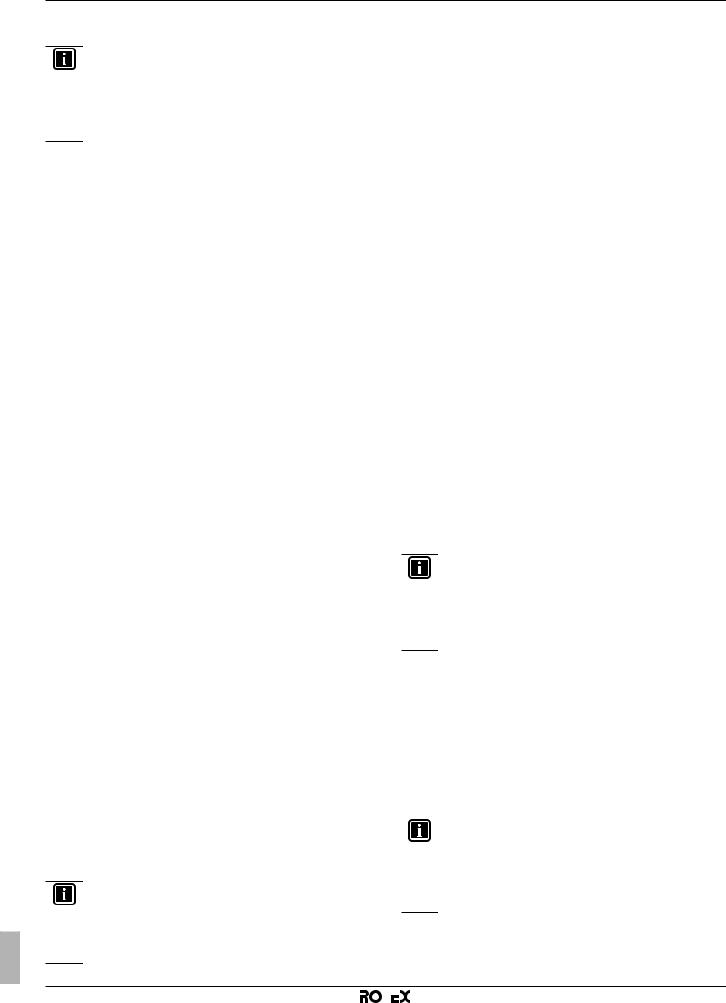
4 About the units and options
For installation instructions, see the installation manual of the domestic hot water tank and addendum book for optional equipment.
INFORMATION
▪The domestic hot water tank can only be connected if control box RKCB07CAV3 is part of the system.
▪The domestic hot water tank is connected to the hydro part of the outdoor unit, and wired to control box RKCB07CAV3.
Remote outdoor sensor (EKRSCA1)
By default the sensor inside the outdoor unit will be used to measure the outdoor temperature.
As an option the remote outdoor sensor can be installed to measure the outdoor temperature on another location (e.g. to avoid direct sunlight) to have an improved system behaviour.
For installation instructions, see the installation manual of the remote outdoor sensor and the addendum book for optional equipment.
Heat pump convector (RFWXV)
For providing space heating/cooling, it is possible to use heat pump convectors (RFWXV).
For installation instructions, refer to the installation manual of the heat pump convectors, and the addendum book for optional equipment.
Room thermostat (RKRTWA, RKRTR1, RTRNETA)
You can connect an optional room thermostat to control box RKCB07CAV3.This thermostat can either be wired (RKRTWA) or wireless (RKRTR1and RTRNETA). Thermostat RTRNETA can only be used in heating-only systems.
For installation instructions, see the installation manual of the room thermostat and addendum book for optional equipment.
Remote sensor for wireless thermostat (EKRTETS)
You can use a wireless indoor temperature sensor (EKRTETS) only in combination with the wireless thermostat (RKRTR1).
For installation intructions, see the installation manual of the room thermostat and addendum book for optional equipment.
PC configurator (EKPCCAB)
The PC cable makes a connection between the switch box of the outdoor unit (or that of control box RKCB07CAV3) and a PC. It gives the possibility to upload different language files to the user interface, and parameters to the outdoor unit. For the available language files, contact your local dealer.
The software and corresponding operating instructions are available on the ROTEX homepage.
For installation instructions, see the installation manual of the PC cable, the "8 Configuration" on page 51 chapter, and the addendum book for optional equipment.
4.3.3Possible options for the control box
User interface (RKRUCBL*)
The user interface and a possible additional user interface are available as an option.
The additional user interface can be connected:
▪To have both:
▪control close to the control box,
▪room thermostat functionality in the principal space to be heated.
To have an interface containing other languages.
Following user interfaces are available:
▪RKRUCBL1 contains following languages: German, French, Dutch, Italian.
▪RKRUCBL2 contains following languages: English, Swedish, Norwegian, Finnish.
▪RKRUCBL3 contains following languages: English, Spanish, Greek, Portuguese.
▪RKRUCBL4 contains following languages: English, Turkish, Polish, Romanian.
▪RKRUCBL5 contains following languages: German, Czech,
Slovenian, Slovakian.
▪RKRUCBL6 contains following languages: English, Croatian, Hungarian, Estonian.
▪RKRUCBL7 contains following languages: English, German,
Russian, Danish.
Languages on the user interface can be uploaded by PC software or copied from an user interface to the other.
For installation instructions, see "7.8.6 To connect the user interface" on page 43.
INFORMATION
▪If control box RKCB07CAV3 is NOT part of the system, connect the user interface directly to the outdoor unit.
▪If control box RKCB07CAV3 is part of the system, you can also connect the user interface to the control box.
4.3.4Possible options for the option box
Remote indoor sensor (KRCS01-1)
By default the internal user interface sensor will be used as room temperature sensor.
As an option the remote indoor sensor can be installed to measure the room temperature on another location.
The remote indoor sensor is connected to option box RK2CB07CAV3. For installation instructions, see the installation manual of the remote indoor sensor and the addendum book for optional equipment.
INFORMATION
▪The remote indoor sensor can only be used in case the user interface is configured with room thermostat functionality.
▪You can only connect either the remote indoor sensor or the remote outdoor sensor.
4.3.5Possible combinations of outdoor unit and domestic hot water tank
Outdoor unit |
Domestic hot water tank |
|
|
HYC 343/19/0-DB |
HYC 544/32/0-DB |
RBLQ05CAV3 |
O |
O |
|
|
|
RBLQ07CAV3 |
O |
O |
RDLQ05CAV3 |
O |
O |
|
|
|
RDLQ07CAV3 |
O |
O |
|
|
|
INFORMATION
▪The domestic hot water tank can only be connected if control box RKCB07CAV3 is part of the system.
▪The domestic hot water tank is connected to the hydro part of the outdoor unit, and wired to control box
RKCB07CAV3.
Installer reference guide |
|
|
|
RBLQ05+07CAV3 + RDLQ05+07CAV3 + RKCB07CAV3 + |
|
|
|||
12 |
|
|
|
RK2CB07CAV3 + RKMBUHCA3V3 + RKMBUHCA9W1 |
|
|
|
ROTEX HPSU low temperature monobloc |
|
|
|
|
|
4P415097-1A – 2016.02 |
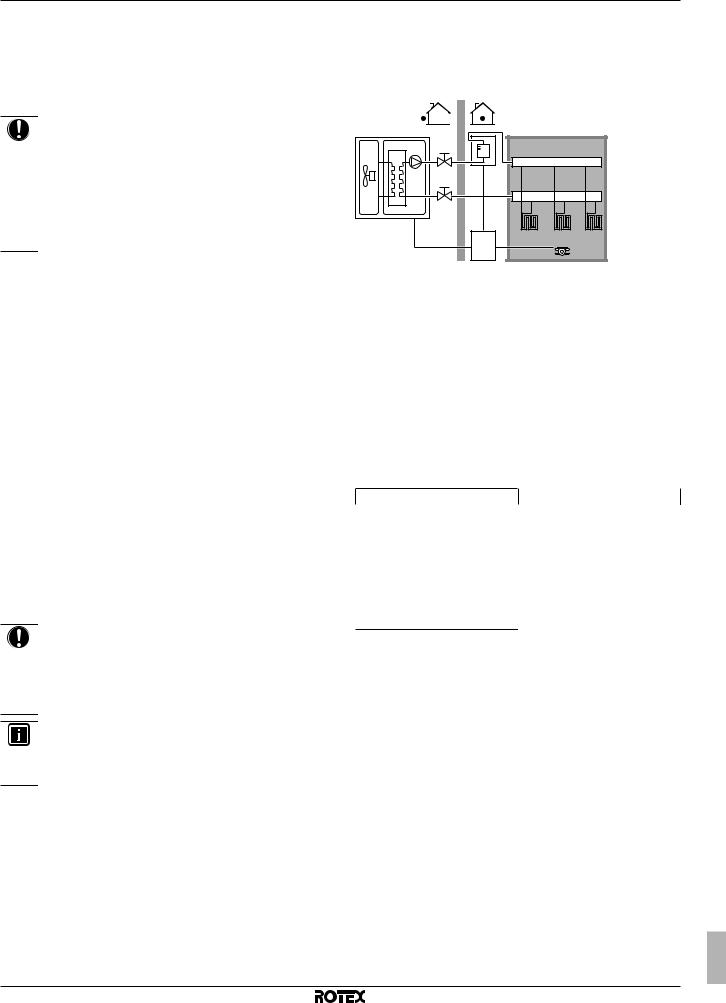
5 Application guidelines
5 Application guidelines
5.1Overview: Application guidelines
The purpose of the application guidelines is to give a glance of the possibilities of the ROTEX heat pump system.
NOTICE
▪The illustrations in the application guidelines are meant for reference only, and are NOT to be used as detailed hydraulic diagrams. The detailed hydraulic dimensioning and balancing are NOT shown, and are the responsibility of the installer.
▪For more information about the configuration settings to optimize heat pump operation, see "8 Configuration" on page 51.
This chapter contains application guidelines for:
▪Setting up the space heating/cooling system
▪Setting up an auxiliary heat source for space heating
▪Setting up the domestic hot water tank
▪Setting up the energy metering
▪Setting up the power consumption
▪Setting up an external temperature sensor
5.2Setting up the space heating/ cooling system
The heat pump system supplies leaving water to heat emitters in one or more rooms.
Because the system offers a wide flexibility to control the temperature in each room, you need to answer the following questions first:
▪ How many rooms are heated (or cooled) by the ROTEX heat pump system?
▪Which heat emitter types are used in each room and what is their design leaving water temperature?
Once the space heating/cooling requirements are clear, ROTEX recommends to follow the setup guidelines below.
NOTICE
If an external room thermostat is used, the external room thermostat will control the room frost protection. However, the room frost protection is only possible if the leaving water temperature control on the unit's user interface is turned ON.
INFORMATION
In case an external room thermostat is used and room frost protection needs to be guaranteed in all conditions, then you have to set auto emergency [A.5.1.2] to 1.
5.2.1Single room
Under floor heating or radiators – Wired room thermostat
Setup
A
B
c
b
 a
a
AMain leaving water temperature zone
BOne single room
aUser interface used as room thermostat
bControl box
cBackup heater (option)
▪The under floor heating or radiators are directly connected to the outdoor unit – or to the backup heater, if there is one.
▪The room temperature is controlled by the user interface, that is connected to control box RKCB07CAV3. Possible installations:
▪Control box RKCB07CAV3 is installed in the room and the user interface is used as room thermostat.
▪Control box RKCB07CAV3 is installed indoors, close to the outdoor unit + user interface installed in the room and used as room thermostat.
Configuration
|
Setting |
|
Value |
|
Unit temperature control: |
2 |
(RT control): Unit operation is |
||
▪ |
#: [A.2.1.7] |
decided based on the ambient |
||
temperature of the user interface. |
||||
▪ |
Code: [C-07] |
|||
|
|
|||
Number of water temperature |
0 |
(1 LWT zone): Main |
||
zones: |
|
|
||
▪#: [A.2.1.8]
▪Code: [7-02]
Benefits
▪Cost effective. You do NOT need an additional external room thermostat.
▪Highest comfort and efficiency. The smart room thermostat functionality can decrease or increase the desired leaving water temperature based on the actual room temperature (modulation).
This results in:
▪Stable room temperature matching the desired temperature
(higher comfort)
▪Less ON/OFF cycles (more quiet, higher comfort and higher efficiency)
▪Lowest possible leaving water temperature (higher efficiency)
▪Easy. You can easily set the desired room temperature via the user interface:
▪For your daily needs, you can use preset values and schedules.
▪To deviate from your daily needs, you can temporarily overrule the preset values and schedules, use the holiday mode…
RBLQ05+07CAV3 + RDLQ05+07CAV3 + RKCB07CAV3 + RK2CB07CAV3 + RKMBUHCA3V3 + RKMBUHCA9W1 ROTEX HPSU low temperature monobloc
4P415097-1A – 2016.02
Installer reference guide
13
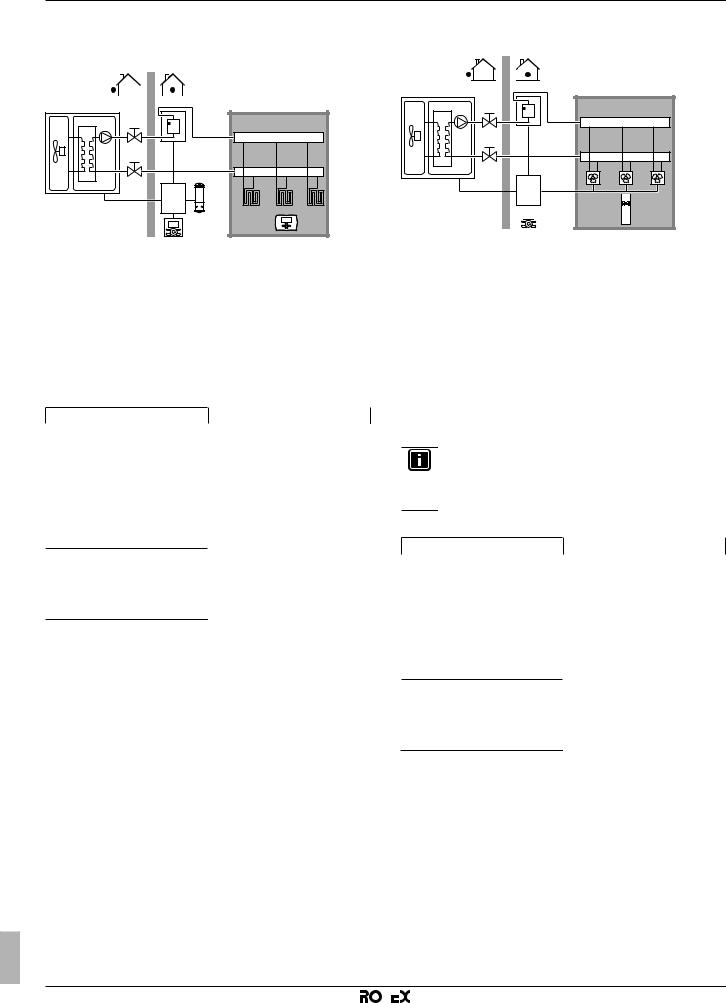
5 Application guidelines
Under floor heating or radiators – Wireless room thermostat
Setup
|
A |
|
B |
c |
|
b |
d |
|
|
a |
e |
AMain leaving water temperature zone
BOne single room
aUser interface
bControl box
cBackup heater (option)
dReceiver for wireless external room thermostat
eWireless external room thermostat
▪The under floor heating or radiators are directly connected to the outdoor unit – or to the backup heater, if there is one.
▪The room temperature is controlled by the wireless external room thermostat (optional equipment RKRTR1).
Configuration
Heat pump convectors
Setup
A
B
c
b


 d
d  a
a
AMain leaving water temperature zone
BOne single room
aUser interface
bControl box
cBackup heater (option)
dRemote controller of the heat pump convectors
▪The under floor heating or radiators are directly connected to the outdoor unit – or to the backup heater, if there is one.
▪The desired room temperature is set via the remote controller of the heat pump convectors.
▪The space heating/cooling demand signal is sent to one digital input on control box RKCB07CAV3 (X2M/1 and X2M/2).
|
Setting |
|
Value |
|
Unit temperature control: |
1 |
(Ext RT control): Unit operation |
||
▪ |
#: [A.2.1.7] |
is decided by the external |
||
thermostat. |
||||
▪ |
Code: [C-07] |
|||
|
|
|||
Number of water temperature |
0 |
(1 LWT zone): Main |
||
zones: |
|
|
||
▪#: [A.2.1.8]
▪Code: [7-02]
External room thermostat for the |
1 (Thermo ON/OFF): When the |
||
main zone: |
used external room thermostat or |
||
▪ |
#: [A.2.2.E.5] |
heat pump convector can only |
|
send a thermo ON/OFF |
|||
▪ |
Code: [C-05] |
||
condition. |
|||
Benefits
▪Wireless. The ROTEX external room thermostat is available in a wireless version.
▪Efficiency. Although the external room thermostat only sends ON/ OFF signals, it is specifically designed for the heat pump system.
▪Comfort. In case of under floor heating, the wireless external room thermostat prevents condensation on the floor during cooling operation by measuring the room humidity.
▪The space operation mode is sent to the heat pump convectors by one digital output on control box RKCB07CAV3 (X8M/6 and
X8M/7).
INFORMATION
When using multiple heat pump convectors, make sure each one receives the infrared signal from the remote controller of the heat pump convectors.
Configuration
|
Setting |
|
Value |
|
Unit temperature control: |
1 |
(Ext RT control): Unit operation |
||
▪ |
#: [A.2.1.7] |
is decided by the external |
||
thermostat. |
||||
▪ |
Code: [C-07] |
|||
|
|
|||
|
|
|
||
Number of water temperature |
0 |
(1 LWT zone): Main |
||
zones: |
|
|
||
▪#: [A.2.1.8]
▪Code: [7-02]
External room thermostat for the |
1 (Thermo ON/OFF): When the |
||
main zone: |
used external room thermostat or |
||
▪ |
#: [A.2.2.E.5] |
heat pump convector can only |
|
send a thermo ON/OFF |
|||
▪ |
Code: [C-05] |
||
condition. |
|||
Benefits
▪Cooling. The heat pump convector offers, besides heating capacity, also excellent cooling capacity.
▪Efficiency. Optimal energy efficiency because of the interlink function.
▪Stylish.
Combination: Under floor heating + Heat pump convectors
▪Space heating is provided by:
▪The under floor heating
▪The heat pump convectors
Installer reference guide |
|
|
|
RBLQ05+07CAV3 + RDLQ05+07CAV3 + RKCB07CAV3 + |
|
|
|||
14 |
|
|
|
RK2CB07CAV3 + RKMBUHCA3V3 + RKMBUHCA9W1 |
|
|
|
ROTEX HPSU low temperature monobloc |
|
|
|
|
|
4P415097-1A – 2016.02 |
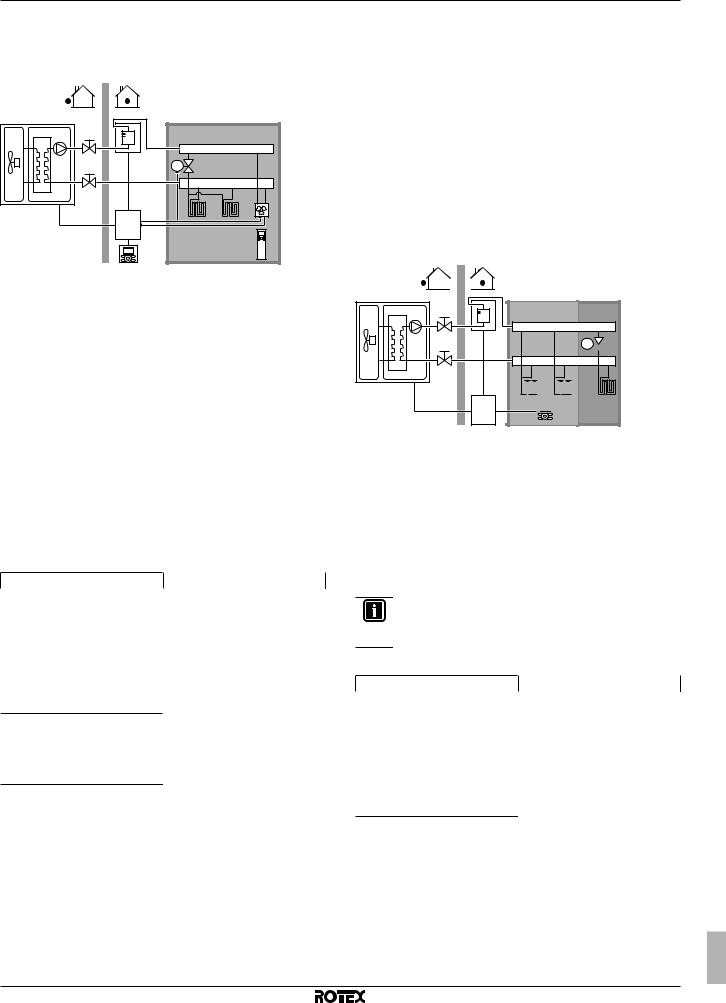
5 Application guidelines
▪Space cooling is provided by the heat pump convectors only. The under floor heating is shut off by the shut-off valve.
Setup
5.2.2Multiple rooms – One LWT zone
If only one leaving water temperature zone is needed because the design leaving water temperature of all heat emitters is the same, you do NOT need a mixing valve station (cost effective).
Example: If the heat pump system is used to heat up one floor where all the rooms have the same heat emitters.
A |
B |
c |
M1 |
b |
d |
a |
Under floor heating or radiators – Thermostatic valves
If you are heating up rooms with under floor heating or radiators, a very common way is to control the temperature of the main room by using a thermostat (this can either be the user interface connected to control box RKCB07CAV3, or an external room thermostat), while the other rooms are controlled by so-called thermostatic valves (field supply), which open or close depending on the room temperature.
Setup
AMain leaving water temperature zone
BOne single room
aUser interface
bControl box
cBackup heater (option)
dRemote controller of the heat pump convectors
▪The heat pump convectors are directly connected to the outdoor unit – or to the backup heater, if there is one.
▪A shut-off valve (field supply) is installed before the under floor heating to prevent condensation on the floor during cooling operation.
▪The desired room temperature is set via the remote controller of the heat pump convectors.
▪The space heating/cooling demand signal is sent to one digital input on control box RKCB07CAV3 (X2M/1 and X2M/2)
▪The space operation mode is sent by one digital output (X8M/6 and X8M/7) on control box RKCB07CAV3 to:
▪The heat pump convectors
▪The shut-off valve
Configuration
|
Setting |
|
Value |
|
Unit temperature control: |
1 |
(Ext RT control): Unit operation |
||
▪ |
#: [A.2.1.7] |
is decided by the external |
||
thermostat. |
||||
▪ |
Code: [C-07] |
|||
|
|
|||
Number of water temperature |
0 |
(1 LWT zone): Main |
||
zones: |
|
|
||
▪#: [A.2.1.8]
▪Code: [7-02]
External room thermostat for the |
1 (Thermo ON/OFF): When the |
||
main zone: |
used external room thermostat or |
||
▪ |
#: [A.2.2.E.5] |
heat pump convector can only |
|
send a thermo ON/OFF |
|||
▪ |
Code: [C-05] |
||
condition. |
|||
Benefits
▪Cooling. Heat pump convectors provide, besides heating capacity, also excellent cooling capacity.
▪Efficiency. Under floor heating has the best performance with
ROTEX HPSU.
▪Comfort. The combination of the two heat emitter types provides: ▪ The excellent heating comfort of the under floor heating
A
B C
c
T 
b 















 a
a
AMain leaving water temperature zone
BRoom 1
CRoom 2
aUser interface
bControl box
cBackup heater (option)
▪The under floor heating of the main room is directly connected to the outdoor unit – or to the backup heater, if there is one.
▪The room temperature of the main room is controlled by the user interface used as thermostat.
▪A thermostatic valve is installed before the under floor heating in each of the other rooms.
INFORMATION
Mind situations where the main room can be heated by another heating source. Example: Fireplaces.
Configuration
|
Setting |
|
Value |
|
Unit temperature control: |
2 |
(RT control): Unit operation is |
||
▪ |
#: [A.2.1.7] |
decided based on the ambient |
||
temperature of the user interface. |
||||
▪ |
Code: [C-07] |
|||
|
|
|||
Number of water temperature |
0 |
(1 LWT zone): Main |
||
zones: |
|
|
||
▪#: [A.2.1.8]
▪Code: [7-02]
Benefits
▪Cost effective.
▪Easy. Same installation as for one room, but with thermostatic valves.
Under floor heating or radiators – Multiple external
▪ The excellent cooling comfort of the heat pump convectors
room thermostats
Setup
RBLQ05+07CAV3 + RDLQ05+07CAV3 + RKCB07CAV3 + RK2CB07CAV3 + RKMBUHCA3V3 + RKMBUHCA9W1 ROTEX HPSU low temperature monobloc
4P415097-1A – 2016.02
Installer reference guide
15
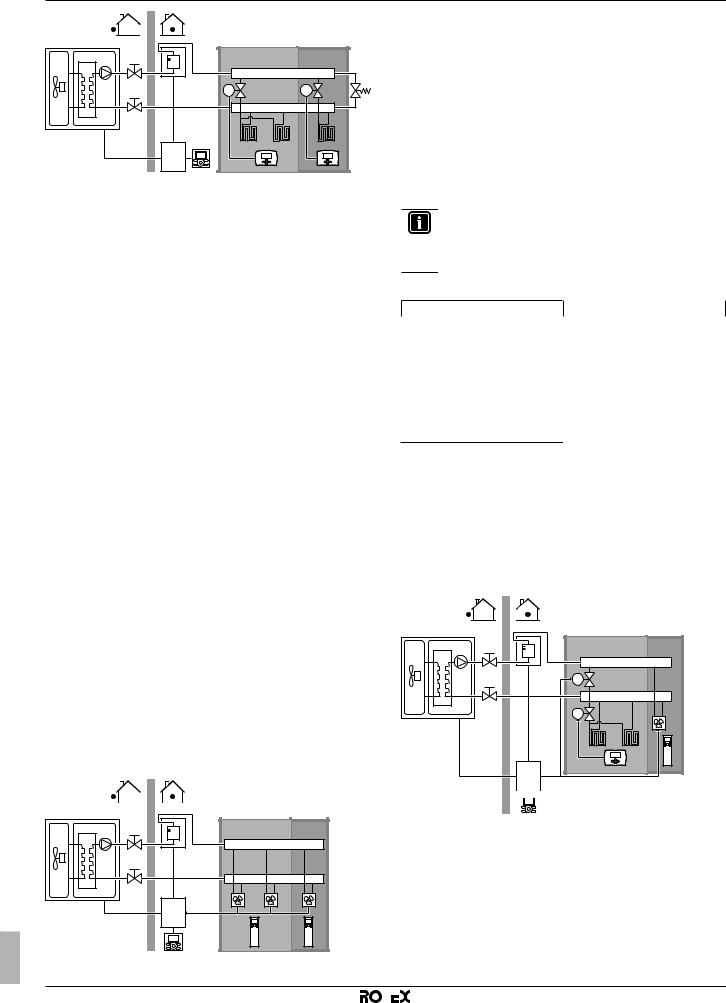
5 Application guidelines
|
|
A |
|
|
|
|
B |
C |
|
c |
|
M1 |
M2 |
d |
|
|
|
||
b |
a |
e |
|
e |
|
|
|||
|
|
|
AMain leaving water temperature zone
BRoom 1
CRoom 2
aUser interface
bControl box
cBackup heater (option)
dBypass valve
eExternal room thermostat
▪For each room, a shut-off valve (field supplied) is installed to avoid leaving water supply when there is no heating or cooling demand.
▪A bypass valve must be installed to make water recirculation possible when all shut-off valves are closed. To guarantee reliable operation, provide a minimum water flow as described in table "To check the water volume and flow rate" in "6.3 Preparing water piping" on page 26.
▪The main user interface (connected to control box RKCB07CAV3) decides the space operation mode. Mind that the space operation mode of the additional user interfaces (used as room thermostat) must be set to match that of the main user interface.
▪The room thermostats are connected to the shut-off valves, and do NOT have to be connected to the outdoor unit. The outdoor unit will supply leaving water all the time, with the possibility to program a leaving water schedule.
Configuration
|
Setting |
Value |
|
Unit temperature control: |
0 (LWT control): Unit operation is |
||
▪ |
#: [A.2.1.7] |
decided based on the leaving |
|
water temperature. |
|||
▪ |
Code: [C-07] |
||
|
|||
Number of water temperature |
0 (1 LWT zone): Main |
||
zones: |
|
||
▪ |
#: [A.2.1.8] |
|
|
▪ |
Code: [7-02] |
|
|
Benefits
Compared with under floor heating or radiators for one room:
▪Comfort. You can set the desired room temperature, including schedules, for each room via the room thermostats.
Heat pump convectors
Setup
A |
C |
B |
|
c |
|
b |
|
d |
d |
a |
|
AMain leaving water temperature zone
BRoom 1
C Room 2
aUser interface
bControl box
cBackup heater (option)
dRemote controller of the heat pump convectors
▪The desired room temperature is set via the remote controller of the heat pump convectors.
▪The main user interface (connected to control box RKCB07CAV3) decides the space operation mode.
▪The heating demand signals of each heat pump convector are connected in parallel to the digital input on control box RKCB07CAV3 (X2M/1 and X2M/2). The outdoor unit will only supply leaving water temperature when there is an actual demand.
INFORMATION
To increase comfort and performance, ROTEX recommends to install the valve kit option EKVKHPC on each heat pump convector.
Configuration
|
Setting |
|
Value |
|
Unit temperature control: |
1 |
(Ext RT control): Unit operation |
||
▪ |
#: [A.2.1.7] |
is decided by the external |
||
thermostat. |
||||
▪ |
Code: [C-07] |
|||
|
|
|||
Number of water temperature |
0 |
(1 LWT zone): Main |
||
zones: |
|
|
||
▪#: [A.2.1.8]
▪Code: [7-02]
Benefits
Compared with heat pump convectors for one room:
▪ Comfort. You can set the desired room temperature, including schedules, for each room via the remote controller of the heat pump convectors.
Combination: Under floor heating + Heat pump convectors
Setup
A |
|
B |
C |
c |
|
M1 |
|
M1 |
|
|
e |
b |
d |
 a
a
AMain leaving water temperature zone
BRoom 1
CRoom 2
aUser interface
bControl box
cBackup heater (option)
dExternal room thermostat
eRemote controller of the heat pump convectors
▪For each room with heat pump convectors: The heat pump convectors are directly connected to the outdoor unit – or to the backup heater, if there is one.
Installer reference guide |
|
|
|
RBLQ05+07CAV3 + RDLQ05+07CAV3 + RKCB07CAV3 + |
|
|
|||
16 |
|
|
|
RK2CB07CAV3 + RKMBUHCA3V3 + RKMBUHCA9W1 |
|
|
|
ROTEX HPSU low temperature monobloc |
|
|
|
|
|
4P415097-1A – 2016.02 |

5 Application guidelines
▪For each room with under floor heating: Two shut-off valves (field supply) are installed before the under floor heating:
▪A shut-off valve to prevent hot water supply when the room has no heating demand
▪A shut-off valve to prevent condensation on the floor during cooling operation of the rooms with heat pump convectors.
▪For each room with heat pump convectors: The desired room temperature is set via the remote controller of the heat pump convectors.
▪For each room with under floor heating: The desired room temperature is set via the external room thermostat (wired or wireless).
▪The main user interface (connected to control box RKCB07CAV3) decides the space operation mode. Mind that the operation mode of each external room thermostat and heat pump convector remote controller must be set to match that of the main user interface.
INFORMATION
To increase comfort and performance, ROTEX recommends to install the valve kit option EKVKHPC on each heat pump convector.
Configuration
|
Setting |
|
Value |
|
Unit temperature control: |
0 |
(LWT control): Unit operation is |
||
▪ |
#: [A.2.1.7] |
decided based on the leaving |
||
water temperature. |
||||
▪ |
Code: [C-07] |
|||
|
|
|||
Number of water temperature |
0 |
(1 LWT zone): Main |
||
zones: |
|
|
||
▪#: [A.2.1.8]
▪Code: [7-02]
5.2.3Multiple rooms – Two LWT zones
If the heat emitters selected for each room are designed for different leaving water temperatures, you can use different leaving water temperature zones (maximum 2).
In this document:
▪Main zone = Zone with the lowest design temperature in heating, and the highest design temperature in cooling
▪Additional zone = The other zone
NOTICE
If there are two leaving water temperature zones, and an external room thermostat is used, then cooling operation is NOT possible.
CAUTION
When there is more than one leaving water zone, you must
ALWAYS install a mixing valve station in the main zone to decrease (in heating)/increase (in cooling) the leaving water temperature when the additional zone has demand.
Typical example:
Room (zone) |
Heat emitters: Design |
|
|
|
temperature |
|
|
Living room (main zone) |
Under floor heating: 35°C |
|
|
|
|
|
|
Bed rooms (additional zone) |
Heat pump convectors: 45°C |
|
|
|
|
|
|
Setup
A
B C
f |
f |
|
e |
D |
d |
E |
|
|
|
|
c |
|
|
b |
|
|
 a
a
AAdditional leaving water temperature zone
BRoom 1
CRoom 2
DMain leaving water temperature zone
ERoom 3
aUser interface
bControl box
cBackup heater (option)
dPressure-regulating valve
eMixing valve station
fRemote controller of the heat pump convectors
INFORMATION
A pressure regulating valve should be implemented before the mixing valve station. This is to guarantee the correct water flow balance between the main leaving water temperature zone and the additional leaving water temperature zone in relation to the required capacity of both water temperature zones.
▪For the main zone:
▪A mixing valve station is installed before the under floor heating.
▪The room temperature is controlled by the user interface, which is used as room thermostat.
NOTICE
ROTEX is NOT responsible for the operation of the mixing valve station pump. It is the responsibility of the installer to guarantee pump operation.
▪For the additional zone:
▪The heat pump convectors are directly connected to the outdoor unit – or to the backup heater, if there is one.
▪The desired room temperature is set via the remote controller of the heat pump convectors for each room.
▪The heating or cooling demand signals of each heat pump convector are connected in parallel to the digital input on control box RKCB07CAV3 (X2M/1 and X2M/2). The outdoor unit will only supply the desired additional leaving water temperature when there is an actual demand.
▪The main user interface (connected to control box RKCB07CAV3) decides the space operation mode. Mind that the operation mode of each heat pump convector remote controller must be set to match that of the main user interface.
RBLQ05+07CAV3 + RDLQ05+07CAV3 + RKCB07CAV3 + RK2CB07CAV3 + RKMBUHCA3V3 + RKMBUHCA9W1 ROTEX HPSU low temperature monobloc
4P415097-1A – 2016.02
Installer reference guide
17
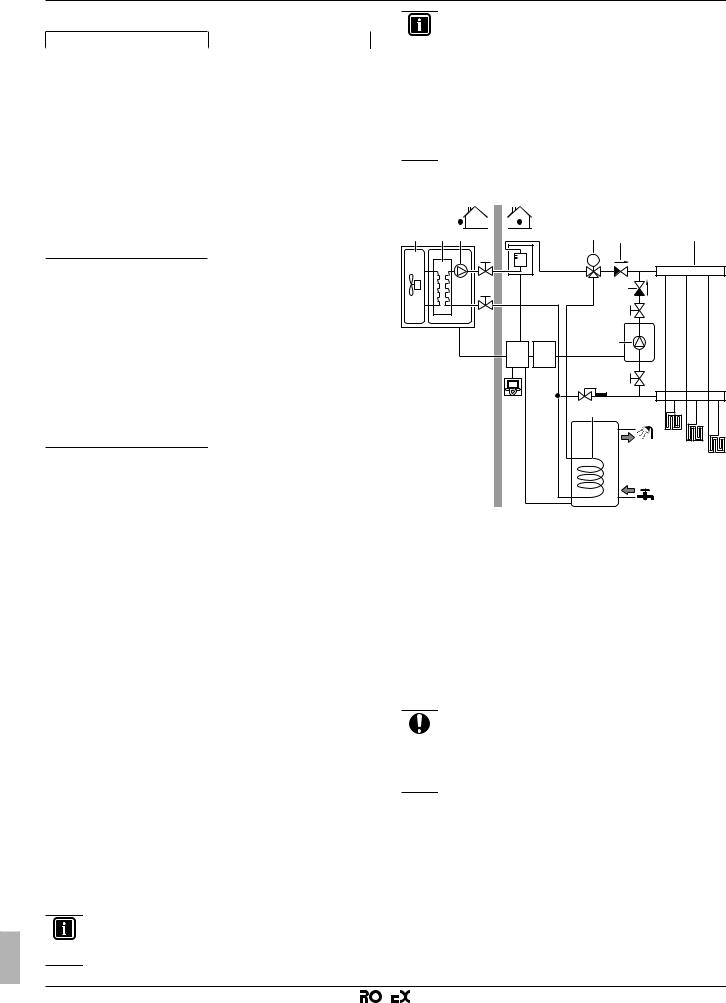
5 Application guidelines
Configuration
|
Setting |
Value |
|
Unit temperature control: |
2 (RT control): Unit operation is |
||
▪ |
#: [A.2.1.7] |
decided based on the ambient |
|
temperature of the user interface. |
|||
▪ |
Code: [C-07] |
||
Note: |
|||
|
|
||
|
|
▪ Main room = user interface |
|
|
|
used as room thermostat |
|
|
|
functionality |
|
|
|
▪ Other rooms = external room |
|
|
|
thermostat functionality |
|
Number of water temperature |
1 (2 LWT zones): Main + |
||
zones: |
additional |
||
▪#: [A.2.1.8]
▪Code: [7-02]
In case of heat pump convectors: |
1 (Thermo ON/OFF): When the |
||
External room thermostat for the |
used external room thermostat or |
||
additional zone: |
heat pump convector can only |
||
send a thermo ON/OFF |
|||
▪ |
#: [A.2.2.5] |
||
condition. No separation between |
|||
▪ |
Code: [C-06] |
heating or cooling demand. |
|
|
|||
|
|
||
Shut off valve |
If the main zone must be shut off |
||
|
|
during cooling mode to prevent |
|
|
|
condensation on the floor, set it |
|
|
|
accordingly. |
|
At the mixing valve station |
Set the desired main leaving |
||
|
|
water temperature for heating |
|
|
|
and/or cooling. |
|
Benefits
▪Comfort.
▪The smart room thermostat functionality can decrease or increase the desired leaving water temperature based on the actual room temperature (modulation).
▪The combination of the two heat emitter systems provides the excellent heating comfort of the under floor heating, and the excellent cooling comfort of the heat pump convectors.
▪Efficiency.
▪Depending on the demand, the outdoor unit supplies different leaving water temperature matching the design temperature of the different heat emitters.
▪Under floor heating has the best performance with ROTEX
HPSU.
5.3Setting up an auxiliary heat source for space heating
▪Space heating can be done by:
▪The outdoor unit
▪An auxiliary boiler (field supply) connected to the system
▪When the room thermostat requests heating, the outdoor unit or the auxiliary boiler starts operating depending on the outdoor temperature (status of the changeover to external heat source).
When the permission is given to the auxiliary boiler, the space heating by the outdoor unit is turned OFF.
▪Bivalent operation is only possible for space heating, NOT for domestic hot water production. Domestic hot water is always produced by the DHW tank connected to the outdoor unit.
INFORMATION
For bivalent operation to be possible, the system requires control box RK2CB07CAV3.
INFORMATION
▪ During heating operation of the heat pump, the heat pump operates to achieve the desired temperature set via the user interface. When weatherdependent operation is active, the water temperature is determined automatically depending on the outdoor temperature.
▪During heating operation of the auxiliary boiler, the auxiliary boiler operates to achieve the desired water temperature set via the auxiliary boiler controller.
Setup
▪ Integrate the boiler as follows:
a |
b |
c |
i |
j |
l |
|
|
d |
M |
|
|
|
|
|
|
|
|
|
|
d |
e |
j |
|
|
|
|
|
||
|
|
|
|
k |
|
|
|
f |
h |
m |
|
|
|
|
|
|
|
|
|
|
n |
k |
|
|
|
|
|
|
 g
g
p
|
FHL1 |
|
FHL2 |
o |
FHL3 |
|
aOutdoor unit
bHeat exchanger
cPump
dShut off valve
eBackup heater (option)
fControl box
gUser interface
hOption box
iMotorised 3 way valve (delivered with the domestic hot water tank)
jNon return valve (field supply)
kShut off valve (field supply)
lCollector (field supply)
mAuxiliary boiler (field supply)
nAquastat valve (field supply)
oDomestic hot water tank (option)
pHeat exchanger coil
FHL1...3 Under floor heating
NOTICE
▪Make sure the auxiliary boiler and its integration in the system complies with applicable legislation.
▪ROTEX is NOT responsible for incorrect or unsafe situations in the auxiliary boiler system.
▪Make sure the return water to the heat pump does NOT exceed 55°C. To do so:
▪Set the desired water temperature via the auxiliary boiler controller to maximum 55°C.
▪ Install an aquastat valve in the return water flow of the heat pump.
▪Set the aquastat valve to close above 55°C and to open below 55°C.
▪Install non-return valves.
▪Make sure to only have one expansion vessel in the water circuit.
An expansion vessel is already pre-mounted in the outdoor unit.
Installer reference guide |
|
|
|
RBLQ05+07CAV3 + RDLQ05+07CAV3 + RKCB07CAV3 + |
|
|
|||
18 |
|
|
|
RK2CB07CAV3 + RKMBUHCA3V3 + RKMBUHCA9W1 |
|
|
|
ROTEX HPSU low temperature monobloc |
|
|
|
|
|
4P415097-1A – 2016.02 |
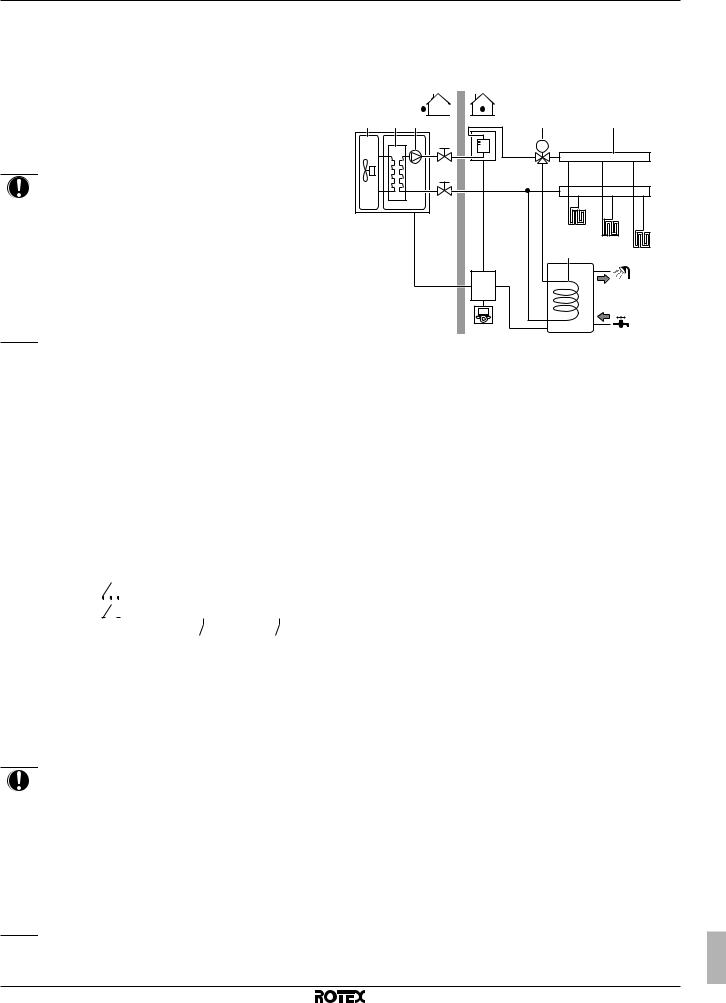
5 Application guidelines
▪Install control box RKCB07CAV3 and option box RK2CB07CAV3.
▪Connect X8M/3 and X8M/4 (changeover to external heat source) on option box RK2CB07CAV3 to the auxiliary boiler thermostat.
▪To setup the heat emitters, see "5.2 Setting up the space heating/ cooling system" on page 13.
Configuration
Via the user interface (quick wizard):
▪Set the use of a bivalent system as external heat source.
▪Set the bivalent temperature and hysteresis.
NOTICE
▪Make sure the bivalent hysteresis has enough differential to prevent frequent changeover between outdoor unit and auxiliary boiler.
▪Because the outdoor temperature is measured by the outdoor unit air thermistor, install the outdoor unit in the shadow so that it is NOT influenced or turned ON/OFF by direct sunlight.
▪Frequent changeover may cause corrosion of the auxiliary boiler. Contact the manufacturer of the auxiliary boiler for more information.
Changeover to external heat source decided by an auxiliary contact
▪Only possible in external room thermostat control AND one leaving water temperature zone (see "5.2 Setting up the space heating/cooling system" on page 13).
▪The auxiliary contact can be:
▪ An outdoor temperature thermostat
5.4Setting up the domestic hot water tank
5.4.1System layout – Standalone DHW tank
a |
b |
c |
|
h |
k |
|
|
|
d |
M |
|
|
|
|
|
|
|
|
|
|
d |
e |
|
|
|
|
|
|
|
|
|
|
|
FHL1 |
FHL2 |
|
|
|
|
j |
|
|
|
|
|
FHL3 |
f
i
 g
g
aOutdoor unit
bHeat exchanger
cPump
dShut off valve
eBackup heater (option)
fControl box
gUser interface
hMotorised 3 way valve
iDomestic hot water tank
jHeat exchanger coil
kCollector (field supply) FHL1...3 Under floor heating
▪An electricity tariff contact
▪A manually operated contact
▪…
▪Setup: Connect the following field wiring:
L |
|
|
|
|
|
|
|
|
|
|
|
|
|
|
|
|
|
|
|
|
|
|
|
|
|
|
|
|
|
|
|
|
|
|
|
|
|
|
|
|
|
|
|
|
|
|
|
|
|
|
|
|
H |
|
|
Com |
|
|
|
|
|
|
|
||||||||
|
|
|
|
|
|
|
|
|
|
|
|
Control box |
|
|
|
|
|
|
|||||
Outdoor/Auto/Boiler |
|
|
|
|
|
|
|
|
|
BTI |
|||||||||||||
|
|
|
|
|
|
|
|
||||||||||||||||
|
|
|
|
|
|
|
|
|
X2M |
|
|||||||||||||
|
|
|
|
|
|
|
|
|
|
||||||||||||||
|
|
|
|
|
|
|
|
|
|
|
|
|
1 |
4 |
|
|
X |
Y |
|
||||
|
|
|
|
|
A |
|
|
|
|
|
|
|
|
|
|
|
|
|
|
|
|
|
|
|
|
|
|
|
|
|
|
|
|
|
|
K1A |
|
K2A |
|
|
|||||||
|
|
|
|
|
|
|
|
|
|
|
|
|
|
|
|
||||||||
N |
|
K1A |
|
|
K2A |
|
|
|
|
|
|
|
|
|
|
||||||||
|
|
|
|
|
|
|
|
|
|||||||||||||||
|
|
|
|
|
|
|
|
|
|
|
|
|
|
|
|
|
|
|
|
|
|
|
|
|
|
|
|
|
|
|
|
|
|
|
|
|
|
|
|
|
|
|
|
|
|
|
|
BTI |
Boiler thermostat input |
|
|
|
|
|
|
||||||||||||||||
A |
Auxiliary contact (normal closed) |
|
|
|
|
|
|
||||||||||||||||
H |
Heating demand room thermostat (optional) |
||||||||||||||||||||||
K1A |
Auxiliary relay for activation of outdoor unit (field supply) |
||||||||||||||||||||||
K2A |
Auxiliary relay for activation of boiler (field supply) |
||||||||||||||||||||||
Outdoor |
Outdoor unit |
|
|
|
|
|
|
||||||||||||||||
Auto |
Automatic |
|
|
|
|
|
|
||||||||||||||||
Boiler |
Boiler |
|
|
|
|
|
|
|
|
|
|
|
|
|
|
|
|
|
|
||||
Control box |
Control box |
|
|
|
|
|
|
||||||||||||||||
NOTICE
▪Make sure the auxiliary contact has enough differential or time delay to prevent frequent changeover between outdoor unit and auxiliary boiler.
▪If the auxiliary contact is an outdoor temperature thermostat, install the thermostat in the shadow so that it is NOT influenced or turned ON/OFF by direct sunlight.
▪Frequent changeover may cause corrosion of the auxiliary boiler. Contact the manufacturer of the auxiliary boiler for more information.
5.4.2Selecting the volume and desired temperature for the DHW tank
People experience water as hot when its temperature is 40°C. Therefore, the DHW consumption is always expressed as equivalent hot water volume at 40°C. However, you can set the DHW tank temperature at a higher temperature (example: 53°C), which is then mixed with cold water (example: 15°C).
Selecting the volume and desired temperature for the DHW tank consists of:
1Determining the DHW consumption (equivalent hot water volume at 40°C).
2Determining the volume and desired temperature for the DHW tank.
Possible DHW tank volumes
Type |
|
Possible volumes |
Standalone DHW tank |
▪ |
300 l |
|
▪ |
500 l |
Energy saving tips
▪If the DHW consumption differs from day to day, you can program a weekly schedule with different desired DHW tank temperatures for each day.
▪The lower the desired DHW tank temperature, the more cost effective. By selecting a larger DHW tank, you can lower the desired DHW tank temperature.
▪The heat pump itself can produce domestic hot water of maximum
55°C (50°C if outdoor temperature is low). The electrical resistance integrated in the heat pump can increase this temperature. However, this consumes more energy. ROTEX recommends to set the desired DHW tank temperature below 55°C to avoid using the electrical resistance.
RBLQ05+07CAV3 + RDLQ05+07CAV3 + RKCB07CAV3 + RK2CB07CAV3 + RKMBUHCA3V3 + RKMBUHCA9W1 ROTEX HPSU low temperature monobloc
4P415097-1A – 2016.02
Installer reference guide
19
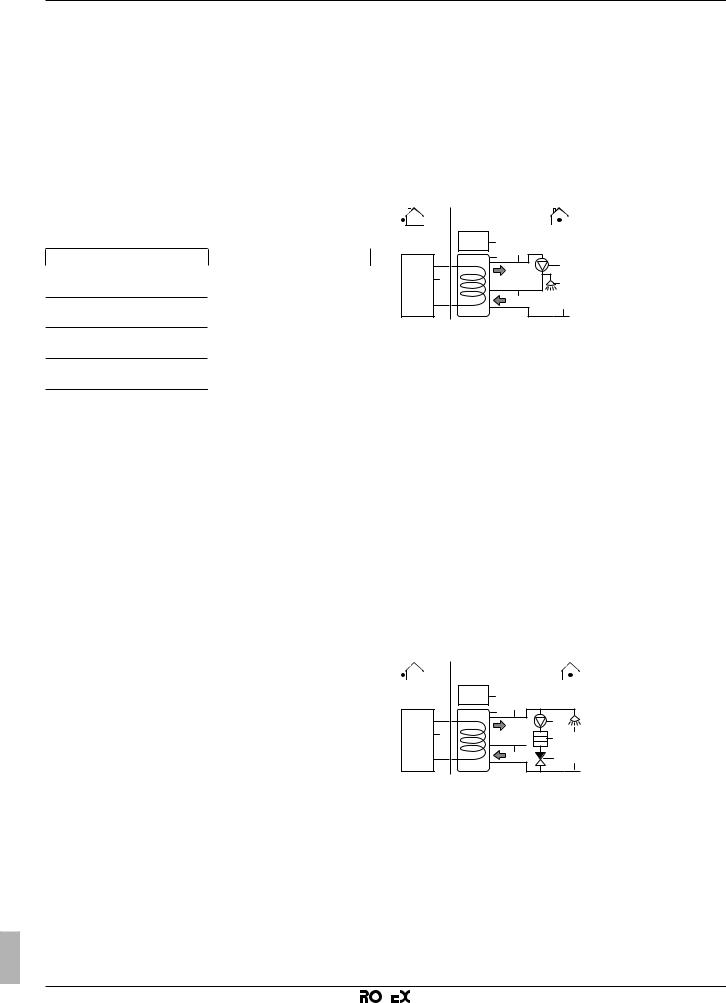
5 Application guidelines
▪The higher the outdoor temperature, the better the performance of the heat pump.
▪If energy prices are the same during the day and the night, ROTEX recommends to heat up the DHW tank during the day.
▪If energy prices are lower during the night, ROTEX recommends to heat up the DHW tank during the night.
▪When the heat pump produces domestic hot water, it cannot heat up a space. When you need domestic hot water and space heating at the same, ROTEX recommends to produce the domestic hot water during the night when there is lower space heating demand.
Determining the DHW consumption
Answer the following questions and calculate the DHW consumption
(equivalent hot water volume at 40°C) using the typical water volumes:
Question |
Typical water volume |
How many showers are needed |
1 shower = 10 min×10 l/min = |
per day? |
100 l |
How many baths are needed per 1 bath = 150 l day?
How much water is needed at the 1 sink = 2 min×5 l/min = 10 l kitchen sink per day?
Are there any other domestic hot — water needs?
Example: If the DHW consumption of a family (4 persons) per day is as follows:
▪3 showers
▪1 bath
▪3 sink volumes
Then the DHW consumption = (3×100 l)+(1×150 l)+(3×10 l)=480 l
Determining the volume and desired temperature for the DHW tank
|
Formula |
|
Example |
V1=V2+V2×(T2−40)/(40−T1) |
If: |
|
|
|
|
▪ |
V2=180 l |
|
|
▪ |
T2=54°C |
|
|
▪ |
T1=15°C |
|
|
Then V1=280 l |
|
V2=V1×(40−T1)/(T2−T1) |
If: |
|
|
|
|
▪ |
V1=480 l |
|
|
▪ |
T2=54°C |
|
|
▪ |
T1=15°C |
|
|
Then V2=307 l |
|
V1 |
DHW consumption (equivalent hot water volume at 40°C) |
||
V2 |
Required DHW tank volume if only heated once |
||
T2 |
DHW tank temperature |
|
|
T1 |
Cold water temperature |
|
|
5.4.3Setup and configuration – DHW tank
▪For large DHW consumptions, you can heat up the DHW tank several times during the day.
▪To heat up the DHW tank to the desired DHW tank temperature, you can use the following energy sources:
▪Thermodynamic cycle of the heat pump
▪Electrical booster heater
▪For more information about:
▪Optimizing the energy consumption for producing domestic hot water, see "8 Configuration" on page 51.
▪Connecting the electrical wiring of the domestic hot water tank to control box RKCB07CAV3, see the installation manual of the domestic hot water tank.
▪Connecting the water piping of the domestic hot water tank to the outdoor unit, see the installation manual of the domestic hot water tank.
5.4.4DHW pump for instant hot water
Setup
d |
g |
|
b |
c |
|
a |
|
|
|
e |
|
|
h |
f |
aOutdoor unit
bDomestic hot water tank
cDomestic hot water pump
dControl box
eShower
fCold water
gDomestic hot water OUT
hRecirculation connection
▪By connecting a DHW pump, instant hot water can be available at the tap.
▪The DHW pump and the installation are field supply and the responsibility of the installer.
▪For more information about the recirculation connection, see
"7.8.8 To connect the domestic hot water pump" on page 45, and the installation manual of the domestic hot water tank.
Configuration
▪For more information, see "8 Configuration" on page 51.
▪You can program a schedule to control the DHW pump via the user interface. For more information, see the user reference guide.
5.4.5DHW pump for disinfection
Setup
h |
h |
|
|
b |
c |
|
|
a |
|
|
|
|
d |
f |
|
|
|
||
|
i |
e |
g |
aOutdoor unit
bDomestic hot water tank
cDomestic hot water pump (field supply)
dHeater element (field supply)
eNon return valve (field supply)
fShower (field supply)
gCold water
hControl box
iDomestic hot water OUT
jRecirculation connection
▪The DHW pump is field-supplied and its installation is the responsibility of the installer.
▪The temperature of the DHW tank can be set to maximum 70°C. If the applicable legislation requires a higher temperature for disinfection, you can connect a DHW pump and heater element as shown above.
Installer reference guide |
|
|
|
RBLQ05+07CAV3 + RDLQ05+07CAV3 + RKCB07CAV3 + |
|
|
|||
20 |
|
|
|
RK2CB07CAV3 + RKMBUHCA3V3 + RKMBUHCA9W1 |
|
|
|
ROTEX HPSU low temperature monobloc |
|
|
|
|
|
4P415097-1A – 2016.02 |
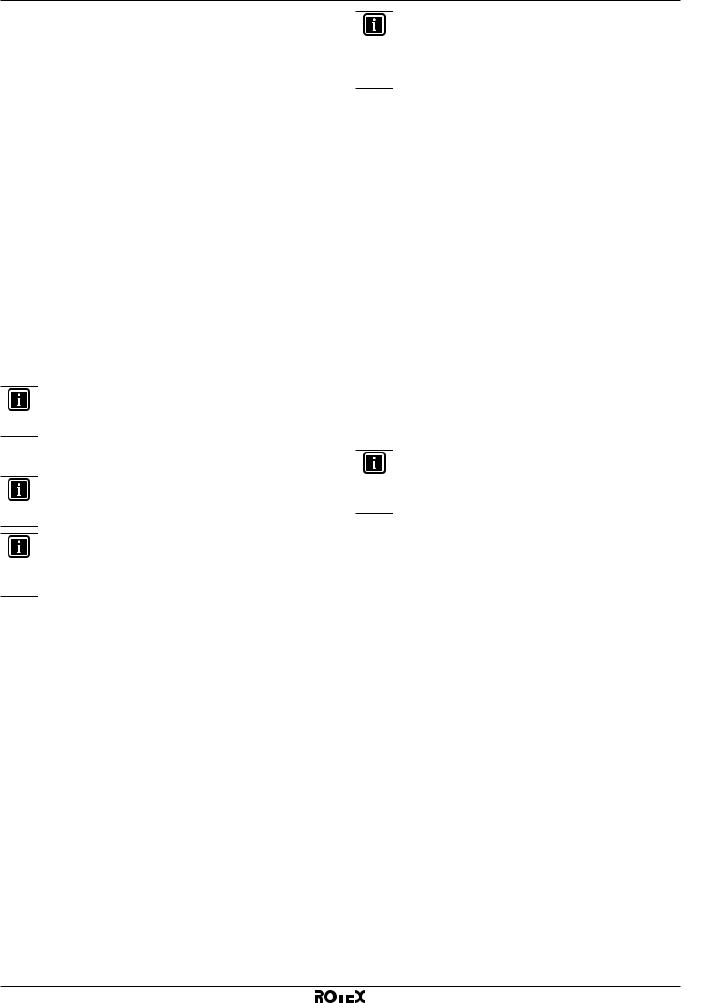
5 Application guidelines
▪If applicable legislation requires disinfection of the water piping until the tapping point, you can connect a DHW pump and heater element (if needed) as shown above.
▪For more information about the recirculation connection, see "7.8.8 To connect the domestic hot water pump" on page 45, and the installation manual of the domestic hot water tank.
Configuration
The outdoor unit can control DHW pump operation. For more information, see "8 Configuration" on page 51.
5.5Setting up the energy metering
▪Via the user interface, you can read out the following energy data:
▪Produced heat
▪Consumed energy
▪You can read out the energy data:
▪For space heating
▪For space cooling
▪For domestic hot water production
▪You can read out the energy data:
▪Per month
▪Per year
INFORMATION
The calculated produced heat and consumed energy are an estimation, the accuracy cannot be guaranteed.
5.5.1Produced heat
INFORMATION
The sensors used to calculate the produced heat are calibrated automatically.
INFORMATION
If glycol is present in the system ([E 0D]=1]), then the produced heat will NOT be calculated, nor will it be displayed on the user interface.
▪Applicable for all models.
▪The produced heat is calculated internally based on:
▪The leaving and entering water temperature
▪The flow rate
▪The power consumption of the booster heater (if applicable) in the domestic hot water tank
▪Setup and configuration:
▪No additional equipment needed.
▪Only in case a booster heater is present in the system, measure its capacity (resistance measurement) and set the capacity via the user interface. Example: If you measure a booster heater resistance of 17.1Ω, the capacity of the heater at 230 V is 3100 W.
5.5.2Consumed energy
You can use the following methods to determine the consumed energy:
▪Calculating
▪Measuring
INFORMATION
You cannot combine calculating the consumed energy (example: for backup heater) and measuring the consumed energy (example: for outdoor unit). If you do so, the energy data will be invalid.
Calculating the consumed energy
▪The consumed energy is calculated internally based on:
▪The actual power input of the outdoor unit
▪The set capacity of the booster heater and the optional backup heater
▪The voltage
▪Setup and configuration: To get accurate energy data, measure the capacity (resistance measurement) and set the capacity via the user interface for:
▪The optional backup heater (step 1 and step 2)
▪The booster heater
Measuring the consumed energy
▪Preferred method because of higher accuracy.
▪Setup and configuration:
▪Requires option box RK2CB07CAV3.
▪Requires external power meters.
▪For the specifications of each type of meter, see "14 Technical data" on page 90.
▪When using electrical power meters, set the number of pulses/ kWh for each power meter via the user interface.
INFORMATION
When measuring the electrical power consumption, make sure ALL power input of the system is covered by the electrical power meters.
5.5.3Normal kWh rate power supply
General rule
One power meter that covers the entire system is sufficient.
Setup
▪Install control box RKCB07CAV3 and option box RK2CB07CAV3.
▪Connect the power meter to X2M/7 and X2M/8 of option box RK2CB07CAV3.
Power meter type
|
In case of… |
Use a… power meter |
|
|
|
Backup heater supplied from a |
Single-phase |
|
|
|
single-phase grid (i.e. the backup |
|
|
|
|
heater model is *3V or *9W |
|
|
|
|
connected to a single-phase grid) |
|
|
|
|
In other cases (i.e. a *9W backup |
Three-phase |
|
|
|
heater model connected to a |
|
|
|
|
three-phase grid) |
|
|
|
|
|
|
|
|
|
|
|
|
|
|
|
|
|
|
RBLQ05+07CAV3 + RDLQ05+07CAV3 + RKCB07CAV3 + RK2CB07CAV3 + RKMBUHCA3V3 + RKMBUHCA9W1 ROTEX HPSU low temperature monobloc
4P415097-1A – 2016.02
Installer reference guide
21
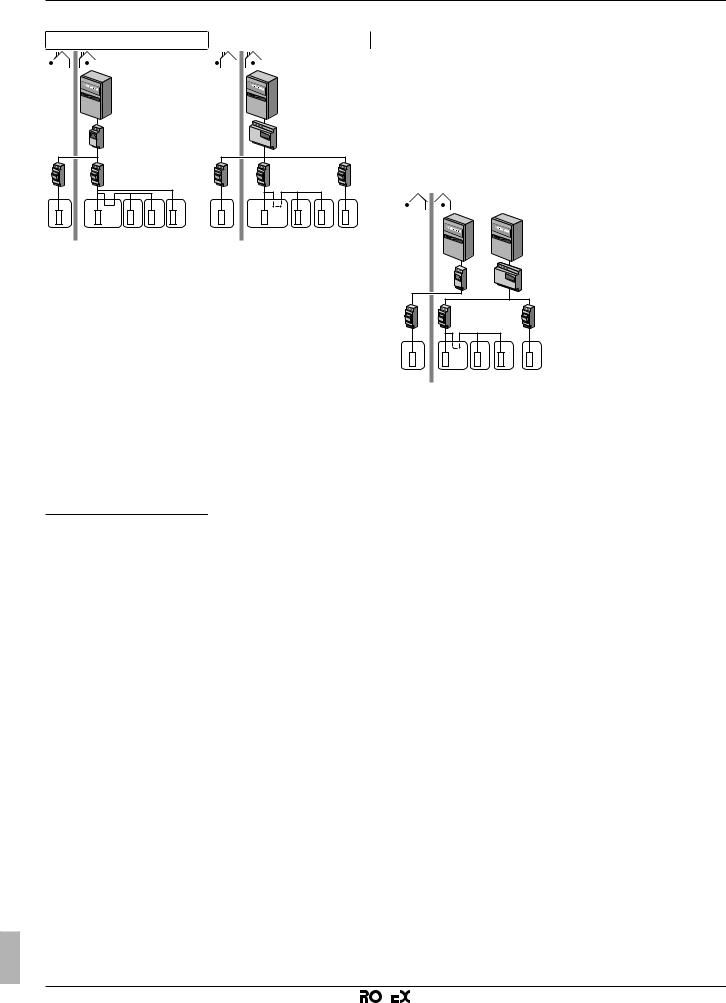
5 Application guidelines
Example
Single-phase power meter |
Three-phase power meter |
|
|
a |
|
|
|
|
a |
|
|
|
b |
|
|
|
|
|
b |
|
|
c |
|
c |
|
|
c |
c |
|
|
d |
d |
e |
f |
g |
h |
e |
f |
g |
h |
i |
A |
B |
C |
D |
E |
A |
B |
C |
D |
E |
A Outdoor unit |
A Outdoor unit |
B Control box |
B Control box |
C DHW tank |
C DHW tank |
D Option box |
D Option box |
E Backup heater kit |
E Backup heater kit |
a Electrical cabinet (L1/N) |
a Electrical cabinet (L1/L2/L3/N) |
b Power meter (L1/N) |
b Power meter (L1/L2/L3/N) |
c Fuse (L1/N) |
c Fuse (L1/N) |
d Outdoor unit (L1/N) |
d Fuse (L1/L2/L3/N) |
e Control box (L1/N) |
e Outdoor unit (L1/N) |
f Booster heater (L1/N) |
f Control box (L1/N) |
g Option box (L1/N) |
g Booster heater (L1/N) |
h Backup heater (L1/N) |
h Option box (L1/N) |
|
i Backup heater (L1/L2/L3/N) |
Exception
▪You can use a second power meter if:
▪The power range of one meter is insufficient.
▪The electrical meter cannot easily be installed in the electrical cabinet.
▪Connect power meter 2 to X2M/9 and X2M/10 of option box RK2CB07CAV3.
Power meter types
▪Power meter 1: Single-phase power meter.
▪Power meter 2:
▪In case of a single-phase backup heater configuration, use a single-phase power meter.
▪In other cases, use a three-phase power meter.
Example
Three-phase backup heater:
|
|
a |
|
b |
|
|
c |
|
d |
e |
e |
|
|
f |
g |
h |
i |
j |
k |
A |
B |
C |
D |
E |
AOutdoor unit
BControl box
CDomestic hot water tank
DOption box
EBackup heater kit
aElectrical cabinet (L1/N): Preferential kWh rate power supply
bElectrical cabinet (L1/L2/L3/N): Normal kWh rate power supply
cPower meter (L1/N)
dPower meter (L1/L2/L3/N)
eFuse (L1/N)
fFuse (L1/L2/L3/N)
gOutdoor unit (L1/N)
hControl box (L1/N)
iBooster heater (L1/N)
jOption box (L1/N)
kBackup heater (L1/L2/L3/N)
▪230 V and 400 V three-phase grids are combined (very uncommon), because of technical limitations of power meters.
▪Connection and setup:
▪Connect the second power meter to X2M/9 and X2M/10 of option box RK2CB07CAV3.
▪In the software the power consumption data of both meters is added so you do NOT have to set which meter covers which power consumption. You only need to set the number of pulses of each power meter.
▪See "5.5.4 Preferential kWh rate power supply" on page 22 for an example with two power meters.
5.5.4Preferential kWh rate power supply
General rule
▪Power meter 1: Measures the refrigerant part of the outdoor unit.
▪Power meter 2: Measures the rest (i.e. the hydro part of the outdoor unit, control box RKCB07CAV3, option box
RK2CB07CAV3, the backup heater kit, and the optional booster heater).
Setup
▪Connect power meter 1 to X2M/7 and X2M/8 of option box RK2CB07CAV3.
5.6Setting up the power consumption control
▪The power consumption control:
▪Allows you to limit the power consumption of the entire system (sum of the outdoor unit, control box RKCB07CAV3, option box RK2CB07CAV3, the backup heater kit, and the optional booster heater).
▪Configuration: Set the power limitation level and how it has to be achieved via the user interface.
▪The power limitation level can be expressed as:
▪Maximum running current (in A)
▪Maximum power input (in kW)
▪The power limitation level can be activated:
▪Permanently
▪By digital inputs
5.6.1Permanent power limitation
Permanent power limitation is useful to assure a maximum power or current input of the system. In some countries, legislation limits the maximum power consumption for space heating and DHW production.
Installer reference guide |
|
|
|
RBLQ05+07CAV3 + RDLQ05+07CAV3 + RKCB07CAV3 + |
|
|
|||
22 |
|
|
|
RK2CB07CAV3 + RKMBUHCA3V3 + RKMBUHCA9W1 |
|
|
|
ROTEX HPSU low temperature monobloc |
|
|
|
|
|
4P415097-1A – 2016.02 |

5 Application guidelines
Pi
a
DI
b
 t
t
Pi Power input t Time
DI Digital input (power limitation level)
aPower limitation active
bActual power input
Setup and configuration
bBackup heater
cBooster heater
Pi |
a |
|
|
DI1 |
|
|
|
|
|
|
|
DI3 |
|
|
|
DI4 |
|
|
b |
|
|
|
|
|
|
Pi |
t |
|
|
||
|
|
Power input |
|
|
|
t |
Time |
DI Digital inputs (power limitation levels)
aPower limitation active
bActual power input
▪No additional equipment needed.
▪Set the power consumption control settings in [A.6.3.1] via the
user interface (for the description of all settings, see
"8 Configuration" on page 51):
▪Select full time limitation mode
▪Select the type of limitation (power in kW or current in A)
▪Set the desired power limitation level
NOTICE
Mind the following guidelines when selecting the desired power limitation level:
▪Set a minimum power consumption of ±3.6 kW to guarantee defrost operation. Otherwise, if defrosting is interrupted several times, the heat exchanger will freeze up.
▪Set a minimum power consumption of ±3 kW to guarantee space heating and DHW production by allowing at least one electrical heater (backup heater step 1 or booster heater).
5.6.2Power limitation activated by digital inputs
Power limitation is also useful in combination with an energy management system.
The power or current of the entire ROTEX system is limited dynamically by digital inputs (maximum four steps). Each power limitation level is set via the user interface by limiting one of the following:
▪Current (in A)
▪Power input (in kW)
The energy management system (field supply) decides the activation of a certain power limitation level. Example: To limit the maximum power of the entire house (lighting, domestic appliances, space heating…).
A |
B |
C |
D |
E |
X2M 

 b
b  c
c
a
F
AOutdoor unit
BControl box
COption box
DBackup heater kit
EDomestic hot water tank
FEnergy management system
a Power limitation activation (4 digital inputs)
Setup
▪Install control box RKCB07CAV3 and option box RK2CB07CAV3.
▪Maximum four digital inputs are used to activate the corresponding power limitation level:
▪DI1 = weakest limitation (highest energy consumption)
▪DI4 = strongest limitation (lowest energy consumption)
▪For the specifications of the digital inputs, and for where to connect them, refer to the wiring diagram.
Configuration
Set the power consumption control settings in [A.6.3.1] via the user interface (for the description of all settings, see "8 Configuration" on page 51):
▪Select activation by digital inputs.
▪Select the type of limitation (power in kW or current in A).
▪Set the desired power limitation level corresponding to each digital input.
INFORMATION
In case more than 1 digital input is closed (at the same time), the digital input priority is fixed: DI4 priority>…>DI1.
5.6.3Power limitation process
The outdoor unit has better efficiency than the electrical heaters. Therefore, the electrical heaters are limited and turned OFF first. The system limits power consumption in the following order:
1 Limits certain electrical heaters.
If… has priority |
Then set the heater priority |
|
via the user interface to… |
Domestic hot water production |
Booster heater. |
|
Result: The backup heater will |
|
be turned OFF first. |
Space heating |
Backup heater. |
|
Result: The booster heater will |
|
be turned OFF first. |
2Turns OFF all electrical heaters.
3Limits the outdoor unit.
4Turns OFF the outdoor unit.
Example
If the configuration is as follows:
▪Power limitation level does NOT allow operation of both booster heater and backup heater (step 1 and step 2).
▪Heater priority = Booster heater.
Then power consumption is limited as follows:
RBLQ05+07CAV3 + RDLQ05+07CAV3 + RKCB07CAV3 + RK2CB07CAV3 + RKMBUHCA3V3 + RKMBUHCA9W1 ROTEX HPSU low temperature monobloc
4P415097-1A – 2016.02
Installer reference guide
23
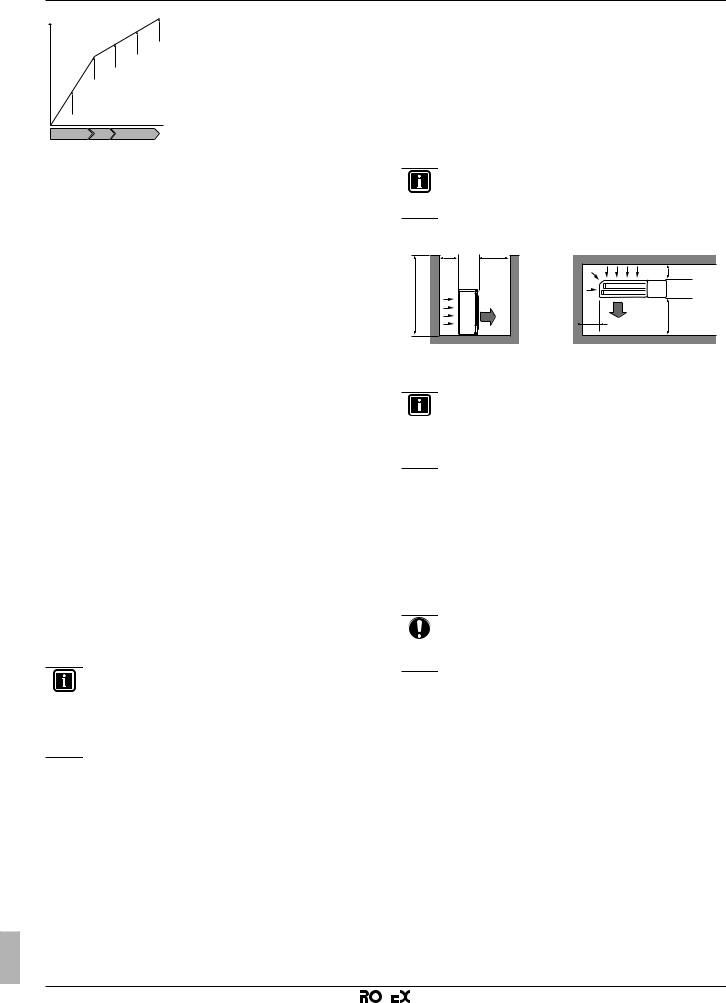
6 Preparation
Ph
e d
c
b
a
A B C  Ce
Ce
6.2Preparing installation site
Do NOT install the unit in places often used as work place. In case of construction works (e.g. grinding works) where a lot of dust is created, the unit must be covered.
Choose the installation location with sufficient place for carrying the unit in and out of the site.
6.2.1Installation site requirements of the
Ph |
Produced heat |
Ce |
Consumed energy |
AOutdoor unit
BBooster heater
CBackup heater
aLimited outdoor unit operation
bFull outdoor unit operation
cBooster heater turned ON
dBackup heater step 1 turned ON
eBackup heater step 2 turned ON
5.7Setting up an external temperature sensor
You can connect one external temperature sensor. It can measure the outdoor ambient temperature. ROTEX recommends to use an external temperature sensor in the following cases:
Outdoor ambient temperature
▪In the outdoor unit, the outdoor ambient temperature is measured.
Therefore, the outdoor unit must be installed on a location:
▪At the north side of the house or at the side of the house where the most heat emitters are located
▪That is NOT exposed to direct sunlight
▪If this is NOT possible, ROTEX recommends to connect a remote outdoor sensor (option EKRSCA1).
▪Setup: For installation instructions, see the installation manual of the remote outdoor sensor and the addendum book for optional equipment.
▪Configuration: Select outdoor sensor [A.2.2.B].
▪During suspend (see "8 Configuration" on page 51), the outdoor unit is turned down to reduce the standby energy losses. As a result, the outdoor ambient temperature is NOT read out.
▪If the desired leaving water temperature is weather dependent, the full time outdoor temperature measurement is important. This is another reason to install the optional outdoor ambient temperature sensor.
INFORMATION
The external outdoor ambient sensor data (either averaged or instantaneous) is used in the weather-dependent control curves and in the automatic heating/cooling changeover logic. To protect the outdoor unit, the internal sensor of the outdoor unit is always used.
outdoor unit
INFORMATION
Also read the precautions and requirements in the
"General safety precautions" chapter.
Mind the following spacing guidelines:
|
>250/400 |
>350 |
| <![if ! IE]> <![endif]>≤1200 |
b |
|
|
a |
|
|
|
|
|
(mm) |
|
|
a |
Air outlet |
|
b |
Air inlet |
|
b |
>250 |
a |
|
|
|
(mm) |
INFORMATION
If shut-off valves are installed on the unit, provide a minimum space of 400 mm at the air inlet side. If shut off valves are NOT installed on the unit, provide a minimum space of 250 mm.
If the system contains a domestic hot water tank, meet the following requirements:
Maximum allowable distance |
Distance |
between outdoor unit and … |
|
domestic hot water tank |
10 m |
|
|
3 way valve |
10 m |
See "14.2 Dimensions and service space" on page 90 for more detailed information about spacing guidelines.
NOTICE
▪Do NOT stack the units on each other.
▪Do NOT hang the unit on a ceiling.
Strong winds (≥18 km/h) blowing against the outdoor unit’s air outlet causes short circuit (suction of discharge air). This may result in:
▪deterioration of the operational capacity;
▪frequent frost acceleration in heating operation;
▪disruption of operation due to decrease of low pressure or increase of high pressure;
6 Preparation
6.1Overview: Preparation
This chapter describes what you have to do and know before going on-site.
It contains information about:
▪Preparing the installation site
▪Preparing the water piping
▪Preparing the electrical wiring
▪a broken fan (if a strong wind blows continuously on the fan, it may start rotating very fast, until it breaks).
It is recommended to install a baffle plate when the air outlet is exposed to wind.
It is recommended to install the outdoor unit with the air inlet facing the wall and NOT directly exposed to the wind.
Do NOT install the unit in the following places:
▪Sound sensitive areas (e.g. near a bedroom and the like), so that the operation noise will cause no trouble.
▪In places where a mineral oil mist, spray or vapour may be present in the atmosphere. Plastic parts may deteriorate and fall off or cause water leakage.
Installer reference guide |
|
|
|
RBLQ05+07CAV3 + RDLQ05+07CAV3 + RKCB07CAV3 + |
|
|
|||
24 |
|
|
|
RK2CB07CAV3 + RKMBUHCA3V3 + RKMBUHCA9W1 |
|
|
|
ROTEX HPSU low temperature monobloc |
|
|
|
|
|
4P415097-1A – 2016.02 |
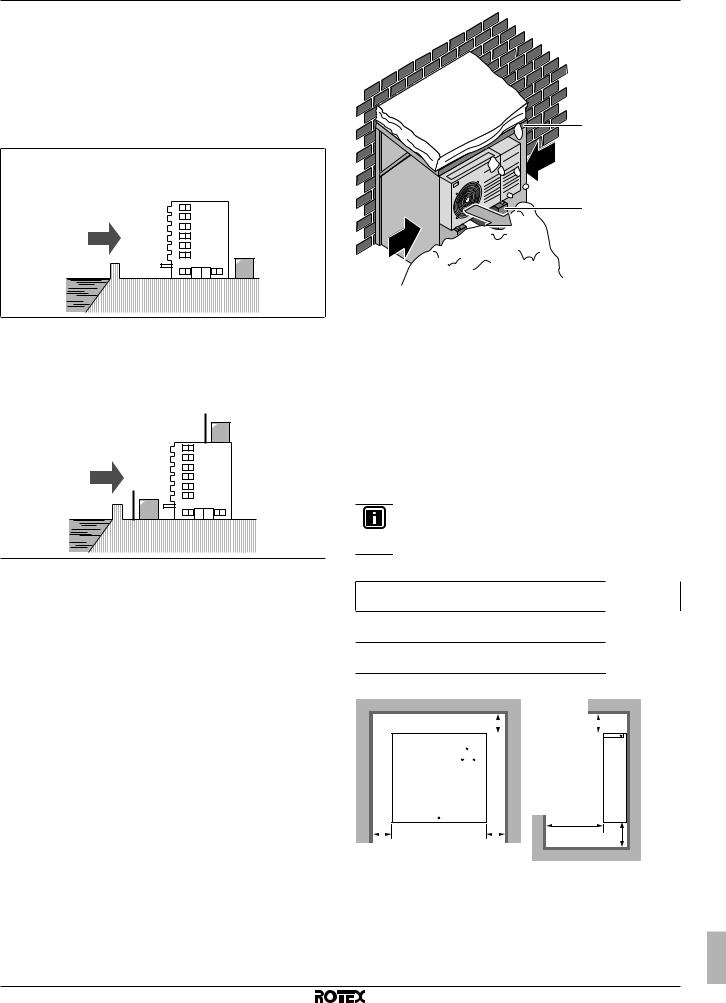
It is NOT recommended to install the unit in the following places because it may shorten the life of the unit:
▪Where the voltage fluctuates a lot
▪In vehicles or vessels
▪Where acidic or alkaline vapour is present
Seaside installation. Make sure the outdoor unit is NOT directly exposed to sea winds. This is to prevent corrosion caused by high levels of salt in the air, which might shorten the life of the unit.
Install the outdoor unit away from direct sea winds.
Example: Behind the building.
b
a
c
If the outdoor unit is exposed to direct sea winds, install a windbreaker.
▪Height of windbreaker≥1.5×height of outdoor unit
▪Mind the service space requirements when installing the windbreaker.
d c
b
a
d c
aSea wind
bBuilding
cOutdoor unit
dWindbreaker
The outdoor unit is designed for outdoor installation only, and for ambient temperatures ranging 10~43°C in cooling mode, –25~25°C in space heating mode, and –25~35°C in domestic hot water operation mode.
6.2.2Additional installation site requirements of the outdoor unit in cold climates
Protect the outdoor unit against direct snowfall and take care that the
outdoor unit is NEVER snowed up.
RBLQ05+07CAV3 + RDLQ05+07CAV3 + RKCB07CAV3 + RK2CB07CAV3 + RKMBUHCA3V3 + RKMBUHCA9W1 ROTEX HPSU low temperature monobloc
4P415097-1A – 2016.02
6 Preparation
a
c
b
d
c
aSnow cover or shed
bPedestal
cPrevailing wind direction
dAir outlet
▪In any case, provide at least 300 mm of free space below the unit. Additionally, make sure the unit is positioned at least 100 mm above the maximum expected level of snow. See "7.3 Mounting the outdoor unit" on page 33 for more details.
In heavy snowfall areas it is very important to select an installation site where the snow will NOT affect the unit. If lateral snowfall is possible, make sure that the heat exchanger coil is NOT affected by the snow. If necessary, install a snow cover or shed and a pedestal.
6.2.3Installation site requirements of the control box
INFORMATION
Also read the precautions and requirements in the "General safety precautions" chapter.
▪ Mind the measurement guidelines:
Maximum distance between control box and |
|
|
|
|
20 m |
|||
outdoor unit |
|
|
|
|
|
|||
Maximum distance between control box and backup |
10 m |
|||||||
heater kit |
|
|
|
|
|
|||
Maximum distance between control box and |
|
|
|
|
10 m |
|||
domestic hot water tank |
|
|
|
|
|
|||
▪ Mind the following spacing installation guidelines: |
|
|||||||
| <![if ! IE]> <![endif]>50 |
|
|
<![if ! IE]> <![endif]>50 |
|
|
|
||
|
|
|
|
|
||||
|
|
|
|
|
|
|
|
|
50 |
50 |
600 |
|
| <![if ! IE]> <![endif]>100 |
|||
|
|
(mm)
▪The control box is designed to be wall-mounted in indoor locations only. Make sure the installation surface is a flat and vertical noncombustible wall.
▪The control box is designed to operate in ambient temperatures ranging from 5~35°C.
Do NOT install the control box in the following places:
Installer reference guide
25

6 Preparation
▪Sound sensitive areas (e.g. near a bedroom and the like), so that the operation noise will cause no trouble.
▪In places with high humidity (max. RH=85%), for example a bathroom.
▪In places where frost is possible.
6.2.4Installation site requirements of the option box
INFORMATION
Also read the precautions and requirements in the "General safety precautions" chapter.
▪ |
Mind the measurement guidelines: |
|
|
|
|
|
|||
|
|
|
|
|
|
|
|
|
|
Maximum distance between the option box and |
|
|
|
|
3 m |
||||
control box RKCB07CAV3 |
|
|
|
|
|
||||
▪ |
Mind the following spacing installation guidelines: |
||||||||
|
<![if ! IE]> <![endif]>50 |
|
|
<![if ! IE]> <![endif]>50 |
|
|
|
||
|
|
|
|
|
|
||||
|
|
|
|
|
|
|
|
|
|
50 |
50 |
600 |
|
| <![if ! IE]> <![endif]>100 |
|||
|
|
(mm)
▪The option box is designed to be wall-mounted in indoor locations only. Make sure the installation surface is a flat and vertical noncombustible wall.
▪The option box is designed to operate in ambient temperatures ranging from 5~35°C.
Do NOT install the option box in the following places:
▪Sound sensitive areas (e.g. near a bedroom and the like), so that the operation noise will cause no trouble.
▪In places with high humidity (max. RH=85%), for example a bathroom.
▪In places where frost is possible.
6.2.5Installation site requirements of the backup heater
INFORMATION
Also read the precautions and requirements in the
"General safety precautions" chapter.
|
|
▪ |
Mind the measurement guidelines: |
|
|
|
|
|
|
|
|
Maximum distance between the backup heater and |
10 m |
|
|
|
the outdoor unit |
|
|
|
|
▪ |
Mind the following spacing installation guidelines: |
|
|
|
|
|
|
|
|
|
|
|
Installer reference guide
26
|
<![if ! IE]> <![endif]>>200 |
|
>50 |
>50 |
>500 |
|
<![if ! IE]> <![endif]>>350 |
|
|
INFORMATION |
|
If the backup heater is installed in a reversible system
(RBLQ05+07CAV3) and valve kit EKMBHBP1 is part of the system, it may be required to provide more space under the backup heater than indicated above. For more information, refer to "7.7.5 About the valve kit" on page 38.
▪The backup heater is designed to be wall-mounted in indoor locations only. Make sure the installation surface is a flat and vertical non-combustible wall.
▪The backup heater is designed to operate in ambient temperatures ranging from 5~30°C.
Do NOT install the backup heater in the following places:
▪Sound sensitive areas (e.g. near a bedroom and the like), so that the operation noise will cause no trouble.
▪In places with high humidity (max. RH=85%), for example a bathroom.
▪In places where frost is possible.
6.3Preparing water piping
6.3.1Water circuit requirements
INFORMATION
Also read the precautions and requirements in the
"General safety precautions" chapter.
▪Connecting piping – Legislation. Make all piping connections in accordance with the applicable legislation and the instructions in the "Installation" chapter, respecting the water inlet and outlet.
▪Connecting piping – Force. Do NOT use excessive force when connecting the piping. Deformation of the piping can cause malfunctioning of the unit.
▪Connecting piping – Tools. Only use appropriate tooling to handle brass, which is a soft material. If NOT, pipes will get damaged.
▪Connecting piping – Air, moisture, dust. If air, moisture or dust gets into the circuit, problems may occur. To prevent this:
▪Only use clean pipes
▪Hold the pipe end downwards when removing burrs.
▪Cover the pipe end when inserting it through a wall, to prevent dust and/or particles entering the pipe.
▪Use a decent thread sealant to seal connections.
NOTICE
If glycol is present in the system, make sure the thread sealant used is resistant to glycol.
RBLQ05+07CAV3 + RDLQ05+07CAV3 + RKCB07CAV3 + RK2CB07CAV3 + RKMBUHCA3V3 + RKMBUHCA9W1 ROTEX HPSU low temperature monobloc 4P415097-1A – 2016.02

6 Preparation
▪Closed circuit. Use the outdoor unit ONLY in a closed water system. Using the system in an open water system will lead to excessive corrosion.
▪Piping length. It is recommended to avoid long runs of piping between the domestic hot water tank and the hot water end point
(shower, bath,…) and to avoid dead ends.
▪Piping diameter. Select the water piping diameter in relation to the required water flow and the available external static pressure of the pump. See "14 Technical data" on page 90 for the external static pressure curves of the outdoor unit.
▪Water flow. It is required to guarantee a minimum flow of 12 l/min.
When the flow is lower, the system will stop operation and display error 7H.
Minimum required flow rate
05+07 models |
12 l/min |
|
|
▪Field supply components – Water and glycol. Only use materials that are compatible with the water (and, if applicable, glycol) used in the system, and with the materials used in the outdoor unit.
▪Field supply components – Water pressure and temperature.
Check that all components in the field piping can withstand the water pressure and water temperature.
▪Water pressure. The maximum water pressure is 3 bar. Provide adequate safeguards in the water circuit to ensure that the maximum pressure is NOT exceeded.
▪Water temperature. All installed piping and piping accessories (valve, connections,…) MUST withstand the following temperatures:
INFORMATION
FHL1...3 Floor heating loop (field supply)
▪Drainage – Low points. Provide drain taps at all low points of the system in order to allow complete drainage of the water circuit.
▪Drainage – Pressure relief valve. Provide a proper drain for the pressure relief valve to avoid water coming into contact with electrical parts.
▪Air vents. Provide air vents at all high points of the system, which must also be easily accessible for servicing. The outdoor unit has a manual air purge valve. The backup heater (option) has an automatic air purge valve. Check that automatic air purge valves are NOT tightened too much, so that the automatic release of air from the water circuit is possible.
▪Zn-coated parts. Never use Zn-coated parts in the water circuit. Because the unit's internal water circuit uses copper piping, excessive corrosion may occur.
▪Non-brass metallic piping. When using non-brass metallic piping, insulate the brass and non-brass properly so that they do NOT make contact with each other. This to prevent galvanic corrosion.
▪Valve – Separating circuits. When using a 3-way valve in the water circuit make sure that the domestic hot water circuit and the floor heating circuit is fully separated.
▪Valve – Change over time. When using a 2-way valve or a 3-way valve in the water circuit, the maximum change-over time of the valve must be 60 seconds.
▪Filter. It is strongly recommended to install an additional filter on the heating water circuit. Especially to remove metallic particles from foul heating piping, it is recommended to use a magnetic or cyclone filter, which can remove small particles. Small particles may damage the unit and will NOT be removed by the standard filter of the heat pump system.
The following illustration is an example and might NOT match your system layout.
65°C |
h |
|
|
|
|
|
|
|
|
|
|
|
|
|
|
|
h |
|
a |
b |
c |
d |
e |
f |
|
g |
FCU1 |
|
|
|
|
|
|
|
|
|
|
FCU2 |
|
|
|
|
|
M |
|
M |
h |
FCU3 |
|
|
|
|
|
|
|
|||
|
|
|
|
|
|
|
|
h |
|
|
|
|
d |
|
|
|
|
|
|
|
|
|
|
|
k |
j |
|
FHL1 FHL2 |
|
|
|
|
|
|
|
|
|
|
FHL3 |
|
|
|
|
|
|
|
|
|
89°C |
|
|
|
|
|
|
|
|
i |
|
aOutdoor unit
bHeat exchanger
cPump
dShut off valve
eBackup heater
fMotorised 3 way valve (supplied with the domestic hot water tank)
gMotorised 2 way valve (field supply)
hCollector
iDomestic hot water tank
jHeat exchanger coil
kBooster heater
FCU1...3 Fan coil unit (optional) (field supply)
▪Domestic hot water tank – Capacity. To avoid stagnation of water, it is important that the storage capacity of the domestic hot water tank meets the daily consumption of domestic hot water.
▪Domestic hot water tank – After installation. Immediately after installation, the domestic hot water tank must be flushed with fresh water. This procedure must be repeated at least once a day the first 5 consecutive days after installation.
▪Domestic hot water tank – Standstills. In cases where during longer periods of time there is no consumption of hot water, the equipment MUST be flushed with fresh water before usage.
▪Domestic hot water tank – Disinfection. For the disinfection function of the domestic hot water tank, see "8.3.2 Domestic hot water control: advanced" on page 66.
▪Thermostatic mixing valves. In accordance with the applicable legislation, it may be necessary to install thermostatic mixing valves.
▪Hygienic measures. The installation must be in compliance with the applicable legislation and may require additional hygienic installation measures.
▪Recirculation pump. In accordance with the applicable legislation, it may be required to connect a recirculation pump in between the hot water end point and the recirculation connection of the domestic hot water tank.
a |
b |
c |
|
d |
|||
|
|
aRecirculation connection
bHot water connection
cShower
dRecirculation pump
RBLQ05+07CAV3 + RDLQ05+07CAV3 + RKCB07CAV3 + RK2CB07CAV3 + RKMBUHCA3V3 + RKMBUHCA9W1 ROTEX HPSU low temperature monobloc
4P415097-1A – 2016.02
Installer reference guide
27

6 Preparation
6.3.2Formula to calculate the expansion vessel pre-pressure
The pre-pressure (Pg) of the vessel depends on the installation height difference (H):
Pg=0.3+(H/10) (bar)
6.3.3To check the water volume and flow rate
The outdoor unit has an expansion vessel of 7 litre with a factory-set pre-pressure of 1 bar
To make sure that the unit operates properly:
▪You must check the minimum and maximum water volume.
▪You might need to adjust the pre-pressure of the expansion vessel.
Minimum water volume
If |
Then |
The system contains a backup |
The minimum water volume is |
heater |
10 l(a) |
The system does NOT contain a |
The minimum water volume is |
backup heater |
20 l(a) |
(a)The internal water volume of the outdoor unit NOT included.
INFORMATION
In critical processes, or in rooms with a high heat load, extra water might be required.
NOTICE
When circulation in each space heating loop is controlled by remotely controlled valves, it is important that the minimum water volume is guaranteed, even if all of the valves are closed.
a |
b |
c |
d |
e |
f |
g |
|
|
|
|
T1 |
T2 |
T3 |
|
|
|
|
M1 |
M2 |
M3 |
|
|
|
d |
|
|
|
|
|
|
|
FHL1 |
|
|
|
|
|
|
|
FHL2 |
|
|
|
|
|
|
|
FHL3 |
aOutdoor unit
bHeat exchanger
cPump
dShut off valve
eBackup heater kit (optional)
fCollector (field supply)
gBy pass valve (field supply) FHL1...3 Floor heating loop (field supply)
T1...3 Individual room thermostat (optional)
M1...3 Individual motorised valve to control loop FHL1...3 (field
supply)
Maximum water volume
NOTICE
The maximum water volume depends on whether glycol is added to the water circuit. For more information on the addition of glycol, refer to "7.7.6 To protect the water circuit against freezing" on page 39.
Use the following graph to determine the maximum water volume for the calculated pre-pressure.
A 2,4 |
|
|
|
|
|
|
|
2,1 |
|
|
|
|
|
|
|
1,8 |
|
|
|
|
|
|
|
1,5 |
|
|
|
|
|
|
|
1,2 |
|
|
|
|
|
|
|
1 |
|
|
|
|
|
|
|
0,9 |
|
|
|
|
|
|
|
0,6 |
|
|
|
|
|
|
|
0,3 |
20 |
70 |
105 120 |
150 |
170 185 |
220 |
270 |
|
|
|
|
|
|
|
B |
APre-pressure (bar)
BMaximum water volume (l) Water
Water + glycol
Example: Maximum water volume and expansion vessel pre-
pressure
Installation |
|
|
|
Water volume |
|
|
||
height |
|
≤185/105 l(b) |
|
>185/105 l(b) |
|
|||
difference(a) |
|
|
|
|
|
|
|
|
≤7 m |
No pre-pressure |
|
Do the following: |
|
||||
|
adjustment is required. |
▪ Decrease |
the |
pre- |
||||
|
|
|
|
|
|
|||
|
|
|
|
|
|
pressure. |
|
|
|
|
|
|
|
|
▪ Check if the water |
||
|
|
|
|
|
|
volume |
does |
NOT |
|
|
|
|
|
|
exceed the maximum |
||
|
|
|
|
|
|
allowed water volume. |
||
>7 m |
Do the following: |
|
The expansion vessel of |
|||||
|
▪ |
Increase |
|
the |
pre- |
the outdoor unit is too |
||
|
|
pressure. |
|
|
small for the installation. |
|||
|
|
|
|
In this case, it is |
|
|||
|
▪ |
Check |
if |
the |
water |
|
||
|
recommended to install |
|||||||
|
|
volume |
does |
NOT |
an extra vessel outside |
|||
|
|
exceed |
the |
maximum |
the unit. |
|
|
|
|
|
allowed water volume. |
|
|
|
|||
(a)This is the height difference (m) between the highest point of the water circuit and the outdoor unit. If the outdoor unit is at the highest point of the installation, the installation height is 0 m.
(b)The maximum water volume is 185 l in case the circuit is only filled with water, and 105 l in case the circuit is filled with water and glycol.
Minimum flow rate
Check that the minimum flow rate (required during defrost/backup heater operation) in the installation is guaranteed in all conditions.
NOTICE
If glycol was added to the water circuit, and the temperature of the water circuit is low, the flow rate will NOT be displayed on the user interface. In this case, the minimum flow rate can be checked by way of the pump test (check that the user interface does NOT display error 7H).
NOTICE
When circulation in each or certain space heating loops is controlled by remotely controlled valves, it is important that the minimum flow rate is guaranteed, even if all valves are closed. In case the minimum flow rate cannot be reached, a flow error 7H will be generated (no heating/operation).
Minimum required flow rate
05+07 models |
12 l/min |
|
|
See the recommended procedure as described in "9.4 Checklist during commissioning" on page 78.
Installer reference guide |
|
|
|
RBLQ05+07CAV3 + RDLQ05+07CAV3 + RKCB07CAV3 + |
|
|
|||
28 |
|
|
|
RK2CB07CAV3 + RKMBUHCA3V3 + RKMBUHCA9W1 |
|
|
|
ROTEX HPSU low temperature monobloc |
|
|
|
|
|
4P415097-1A – 2016.02 |
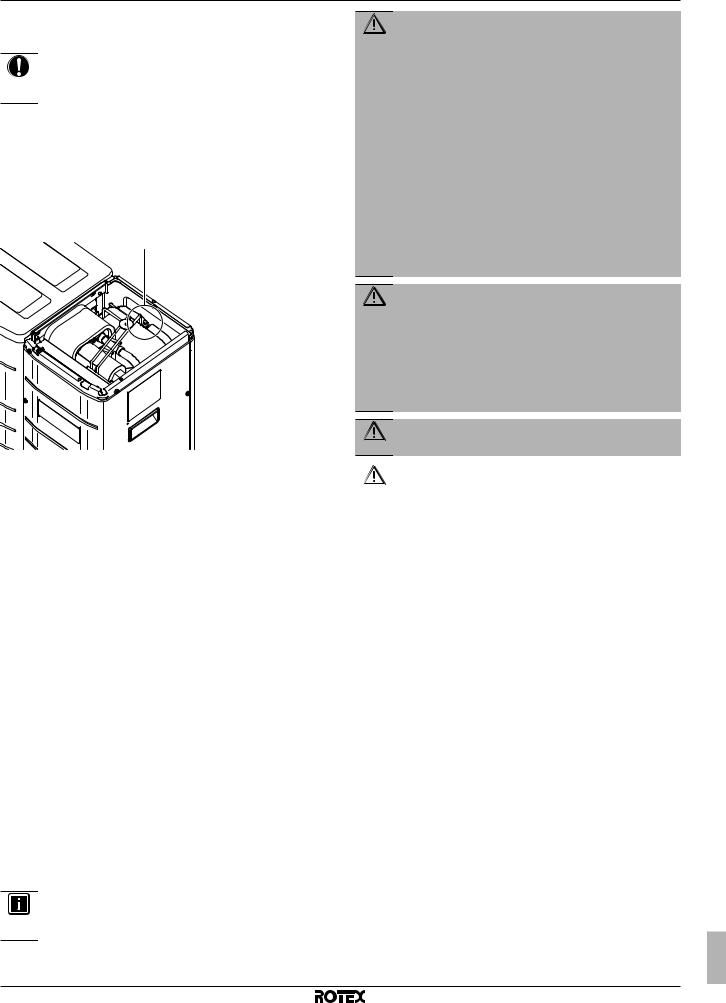
6 Preparation
6.3.4Changing the pre-pressure of the expansion vessel
NOTICE
Only a licensed installer may adjust the pre-pressure of the expansion vessel.
When changing the default pre-pressure of the expansion vessel (1 bar) is required, take following guidelines into account:
▪Only use dry nitrogen to set the expansion vessel pre-pressure.
▪Inappropriate setting of the expansion vessel pre-pressure will lead to malfunction of the system.
Changing the pre-pressure of the expansion vessel should be done by releasing or increasing nitrogen pressure through the schräder valve of the expansion vessel.
a
a Schräder valve
WARNING
▪If the power supply has a missing or wrong N-phase, equipment might break down.
▪Establish proper earthing. Do NOT earth the unit to a utility pipe, surge absorber, or telephone earth.
Incomplete earthing may cause electrical shock.
▪Install the required fuses or circuit breakers.
▪Secure the electrical wiring with cable ties so that the cables do NOT come in contact with sharp edges or piping, particularly on the high-pressure side.
▪Do NOT use taped wires, stranded conductor wires, extension cords, or connections from a star system.
They can cause overheating, electrical shock or fire.
▪Do NOT install a phase advancing capacitor, because this unit is equipped with an inverter. A phase advancing capacitor will reduce performance and may cause accidents.
WARNING
▪All wiring must be performed by an authorized electrician and must comply with the applicable legislation.
▪Make electrical connections to the fixed wiring.
▪All components procured on the site and all electrical construction must comply with the applicable legislation.
WARNING
The backup heater should have a dedicated power supply.
6.3.5 |
To check the water volume: Examples |
WARNING |
ALWAYS use multicore cable for power supply cables. |
||
Example 1 |
|
|
The outdoor unit is installed 5 m below the highest point in the water circuit. The total water volume in the water circuit is 100 l.
No actions or adjustments are required.
6.4.2About preferential kWh rate power supply
Electricity companies throughout the world work hard to provide reliable electric service at competitive prices and are often authorized to bill clients at benefit rates. E.g. time-of-use rates, seasonal rates, Wärmepumpentarif in Germany and Austria, ...
Example 2
The outdoor unit is installed at the highest point in the water circuit. The total water volume in the water circuit is 350 l. The concentration of propylene glycol is 35%.
Actions:
▪Because the total water volume (350 l) is more than the default water volume (105 l), the pre-pressure must be decreased.
▪The required pre-pressure is:
Pg = (0.3+(H/10)) bar = (0.3+(0/10)) bar=0.3 bar.
▪The corresponding maximum water volume at 0.3 bar is 150 l.
(See the graph in the chapter above).
▪Because 350 l is more than 150 l, the expansion vessel is NOT appropriate for the installation. Therefore the system requires an external expansion vessel.
6.4Preparing electrical wiring
6.4.1About preparing electrical wiring
INFORMATION
Also read the precautions and requirements in the
"General safety precautions" chapter.
This equipment allows for connection to such preferential kWh rate power supply delivery systems.
Consult with the electricity company acting as provider at the site where this equipment is to be installed to know whether it is appropriate to connect the equipment in one of the preferential kWh rate power supply delivery systems available, if any.
When the equipment is connected to such preferential kWh rate power supply, the electricity company is allowed to:
▪interrupt power supply to the equipment for certain periods of time;
▪demand that the equipment only consumes a limited amount of electricity during certain periods of time.
Control box RKCB07CAV3 is designed to receive an input signal by which it switches the outdoor unit into forced-off mode. At that moment, the compressor will not operate.
Whether the power supply is interrupted or not, the wiring to the unit is different.
6.4.3Overview of electrical connections except external actuators
RBLQ05+07CAV3 + RDLQ05+07CAV3 + RKCB07CAV3 + RK2CB07CAV3 + RKMBUHCA3V3 + RKMBUHCA9W1 ROTEX HPSU low temperature monobloc
4P415097-1A – 2016.02
Installer reference guide
29
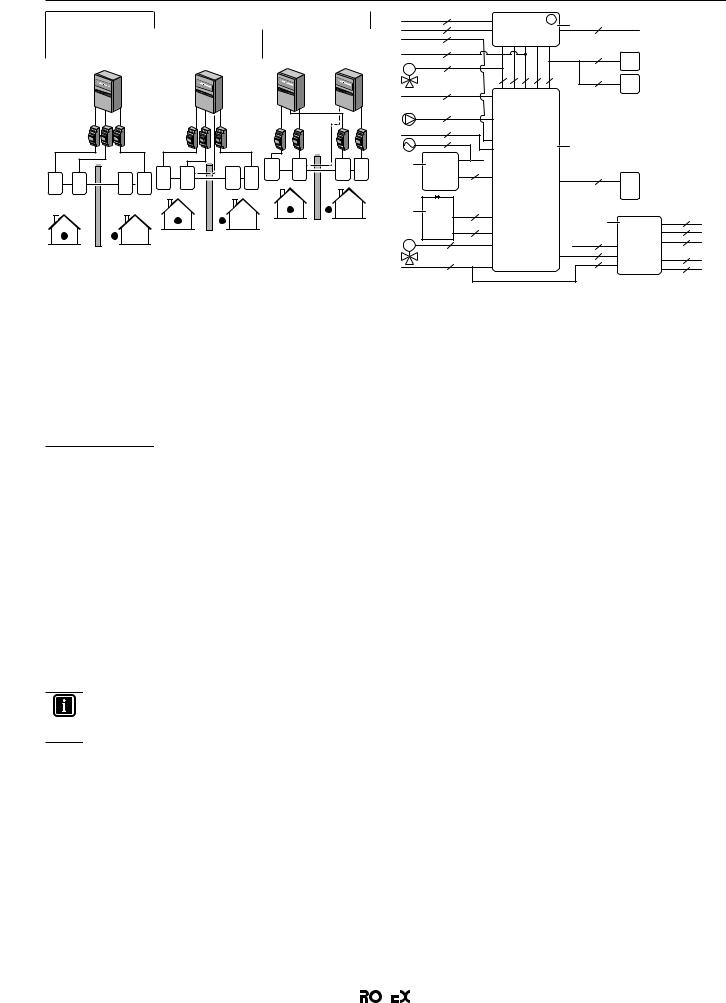
6 Preparation
Normal power |
Preferential kWh rate power supply |
||
supply |
Power supply is |
Power supply is |
|
|
NOT interrupted |
|
interrupted |
a |
b |
a |
b |
|
|
|
|
|
|
|
|
|
5 |
4 |
|
7 |
1 |
|
5 |
4 |
|
1 |
|
|
5 |
|
1 |
|
|
|
|
|
|
|
|
|
|
4 |
|
3 |
|
6 |
|
|
|
|
|
|
|
|
|
3 |
6 |
2 |
|
|
|
|
|
|
|
2 |
|
|
|
f |
e |
2 |
c |
d |
|||
|
|
|
|
f |
e |
||||||||
f |
3 e |
|
d |
c |
|
d |
c |
|
|
|
|
||
|
|
|
|
|
|
|
|
|
|
During preferential |
During preferential |
kWh rate power |
|
kWh rate power |
supply activation, |
supply activation, |
power supply is |
power supply is NOT |
interrupted |
interrupted. The |
immediately or after |
outdoor unit is turned |
some time by the |
off by the control. |
electricity company. |
Remark: The |
In this case, the |
electricity company |
hydro part of the |
must always allow the |
outdoor unit (and the |
power consumption |
control box, if part of |
of the hydro part of |
the system) must be |
the outdoor unit (and |
powered by a |
of the control box, if |
separate normal |
part of the system). |
power supply. |
aNormal power supply
bPreferential kWh rate power supply
cHydro part of the outdoor unit
dRefrigerant part of the outdoor unit
eControl box
fBackup heater kit
1Power supply for outdoor unit
2Interconnection cable to control box
3Interconnection cable to backup heater kit
4Power supply for control box
5Power supply for backup heater kit
6Preferential kWh rate power supply (voltage free contact)
7Normal kWh rate power supply (to power the hydro part of the outdoor unit in the event of a power supply interruption of the preferential kWh rate power supply)
6.4.4Overview of electrical connections for external and internal actuators
The following illustration shows the required field wiring.
INFORMATION
The following illustration is an example and might NOT match your system layout.
|
1 |
|
|
|
c 4 |
|
|
2 |
|
|
|
|
|
|
13 |
|
|
|
|
|
|
5 |
|
|
|
3 |
|
|
21 |
|
|
|
|
|
M |
|
|
|
|
|
|
11 9 |
10 |
7 |
8 |
12 |
|
|
|
|
|||||
|
|
|
|
|
|
|
|
15 |
|
|
|
|
|
|
14 |
|
|
|
|
|
|
18 |
|
|
|
|
|
|
a |
|
|
|
d |
|
b |
|
|
|
|
|
|
22 |
|
|
|
|
|
|
|
|
|
|
20 |
|
|
|
|
|
|
|
|
|
f |
17 |
|
|
|
e |
28 |
|
19 |
|
|
|
||
|
|
|
|
|
30 |
|
M |
16 |
|
|
|
27 |
29 |
|
|
|
|
24 |
26 |
|
|
|
|
|
|
||
|
6 |
|
|
|
23 |
|
|
|
|
|
25 |
aBackup heater power supply
bBackup heater kit
cOutdoor unit
dControl box
eOption box
fDomestic hot water tank
Outdoor unit
Item |
Description |
Wires |
Maximum |
|
|
|
running |
|
|
|
current |
Power supply |
|
|
|
1 |
Power supply for |
2+GND |
(a) |
|
|||
|
outdoor unit |
|
|
2 |
Normal kWh rate power |
2 |
6.3 A |
|
supply |
|
|
User interface |
|
|
|
3 |
User interface |
2 |
(b) |
|
|||
|
|
|
|
Optional equipment |
|
|
|
4 |
Remote outdoor sensor |
2 |
(c) |
|
|||
Field-supplied components |
|
|
|
5 |
Space heating/cooling |
2 |
(c) |
|
|||
|
operation control (or |
|
|
|
shut off valve) |
|
|
(a)Refer to name plate on outdoor unit.
(b)Cable section 0.75 mm² till 1.25 mm²; maximum length: 500 m. Applicable for both single user interface and dual user interface connection.
(c)Minimum cable section 0.75 mm².
Control box
Item |
Description |
Wires |
Maximum |
|
|
|
running |
|
|
|
current |
Power supply |
|
|
|
6 |
Power supply for |
2+GND |
(a) |
|
|||
|
control box |
|
|
|
|
|
|
Interconnection cable |
|
|
|
7 |
Interconnection cable |
2 |
(b) |
|
|||
|
between outdoor unit |
|
|
|
and control box |
|
|
8 |
Interconnection cable |
2 |
(c) |
|
|||
|
for the user interface |
|
|
|
(between outdoor unit |
|
|
|
and control box) |
|
|
|
|
|
|
|
|
|
|
|
|
|
|
|
|
|
|
Installer reference guide |
|
|
|
RBLQ05+07CAV3 + RDLQ05+07CAV3 + RKCB07CAV3 + |
|
|
|
|
|
||
|
|
|||||
30 |
|
|
|
RK2CB07CAV3 + RKMBUHCA3V3 + RKMBUHCA9W1 |
||
|
|
|
ROTEX HPSU low temperature monobloc |
|||
|
|
|
|
|
|
4P415097-1A – 2016.02 |
